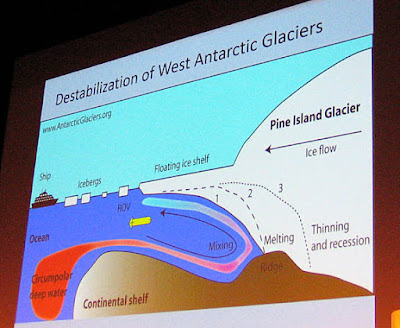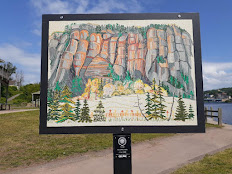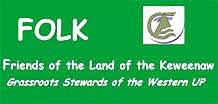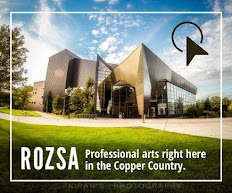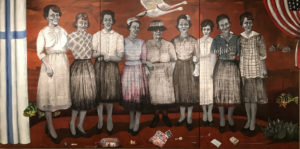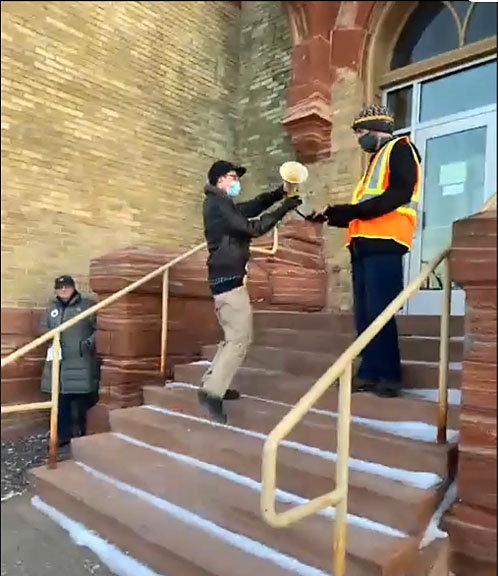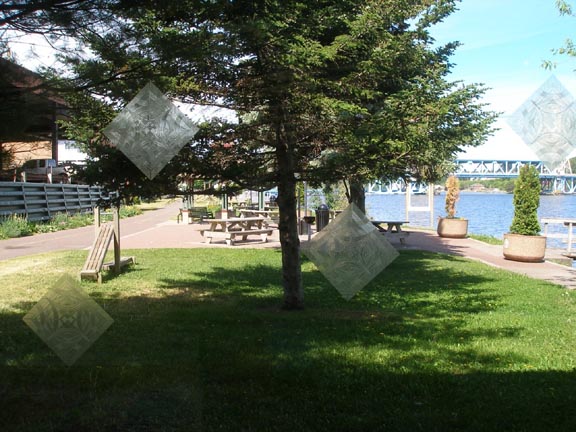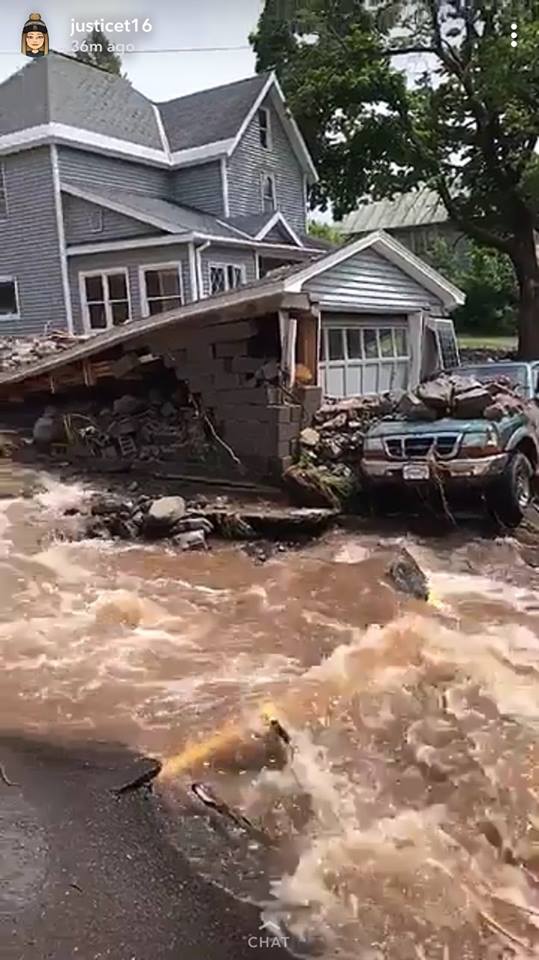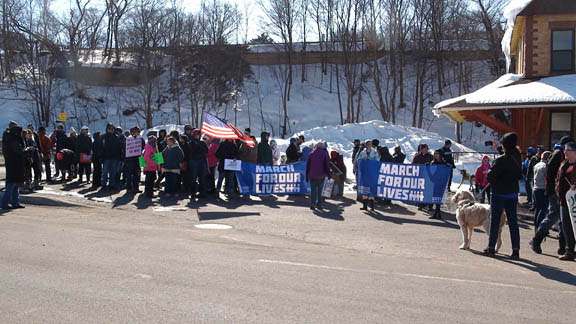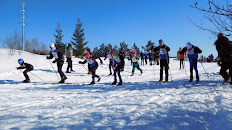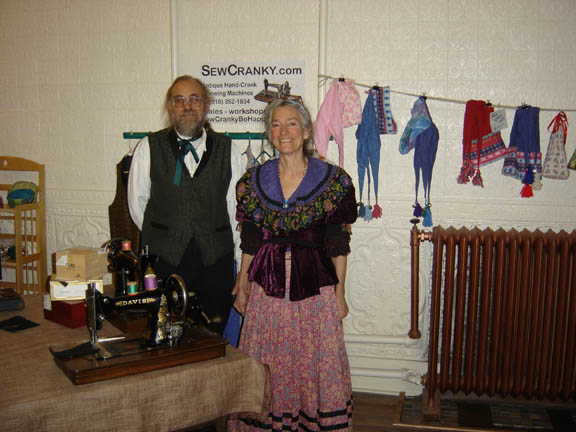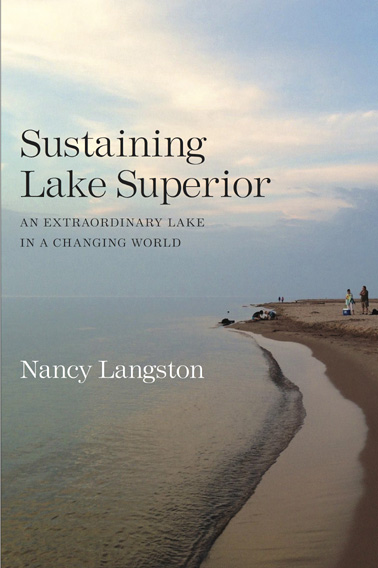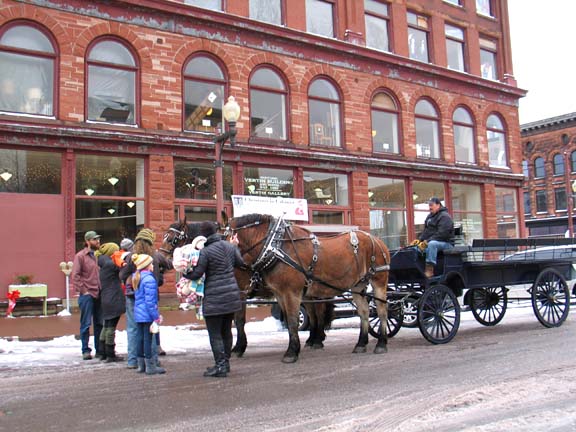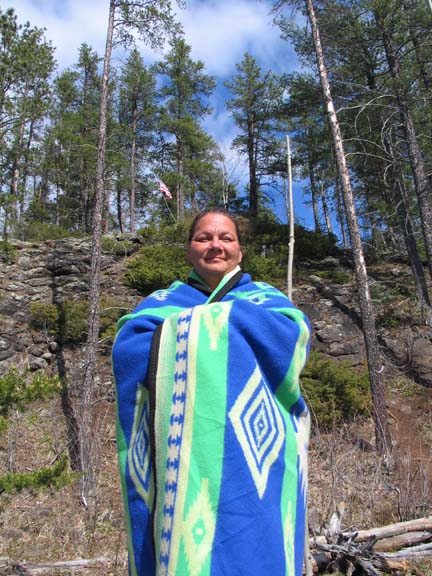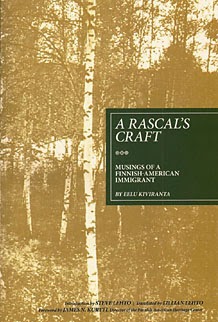This map shows the approximate location of the new Houghton County Cardboard Recycling Center in Atlantic Mine.
HOUGHTON -- If you're a Houghton County resident but not a resident of the City of Hancock, which has curbside recycling, you can benefit from FREE recycling of CARDBOARD beginning Monday, Jan. 4, at the new Houghton County Cardboard Recycling Center located adjacent to the Houghton County Transfer Station in Atlantic Mine.*
Hours will be Monday through Friday from 8 a.m. to 4 p.m. and Saturday 8 a.m. to 2 p.m. DRIVING DIRECTIONS FROM HOUGHTON: Head west on highway M26 toward Atlantic Mine/South Range. One mile past the stoplight at Green Acres Road turn right onto Erickson Drive. The Recycling Center is on the right after about 0.1 mile. The address is 17808 Erickson Dr. Call (906) 482-8872 for information.
Acceptable materials are the following: corrugated cardboard; boxes made of paperboard (shoe, cereal, detergent boxes…); brown grocery bags and packaging; frozen pizza boxes; boxes with small amounts of tape, staples, plastic windows.
Note: All boxes should be free of food and flattened/broken down. Do not place recyclables in plastic bags.
Unacceptable materials: food; grease- or oil-saturated materials; paper products such as newspapers, magazines, junk mail; plastic or plastic bags; styrofoam.
The cardboard products you recycle will be sold to industries that use recycled cardboard to manufacture new products. The money from the sale of the cardboard will be used for operating costs at the Houghton County Recycling Center.
Cardboard and paper waste make up 41 percent of the municipal solid waste stream; in other words, cardboard is the biggest manufactured product in the waste stream by weight.
Recycling cardboard takes 24 percent less energy and produces 50 percent less sulfur dioxide than making cardboard from raw materials. Individuals who recycle will see a reduction in their costs for waste disposal. Waste Management is now charging for recycling, but at the Houghton County transfer station this cardboard recycling is free for residential users; commercial users must check with the office for rates.
One ton of recycled cardboard saves 390 kW hours of electricity, 46 gallons of oil, 6.6 million Btus of energy and 9 cubic yards of landfill space.
The Houghton County Cardboard Recycling Center is funded with a $90,000 grant from the Michigan Department of Environmental Quality (MDEQ) to Houghton County. The Copper Country Recycling Initiative and the Houghton County Board of Commissioners were instrumental in the development of this new cardboard recycling center.
Celebration Jan. 16 at Portage Lake District Library
Celebrate the opening of the Houghton County Cardboard Recycling Center at a special, fun-filled event planned for 11 a.m. - 1 p.m. Saturday, Jan. 16, at the Portage Lake District Library. Lots of fun hands-on activities for kids are planned, including Making Paper, Garbage Pizzas, Recycling Machine, Making Forts, Waste-Free Lunch Safari, and more! A recycling display and information on plans for how to improve curbside recycling in Houghton County will be available, including information on how you can get involved.
Everyone is invited to enjoy FREE refreshments and cake. Several children’s recycling books and other prizes will be raffled.
*Editor's Note: Hancock residents are encouraged to take advantage of monthly curbside recycling, usually on the last Thursday of the month. Click here for details.
Thursday, December 31, 2015
Tuesday, December 29, 2015
Peace Corps takes Michigan Tech grad student to Kyrgyz Republic
Peace Corps Volunteer Cole Bedford, left, is pictured here with a community member wearing a kalpak, traditional Kyrgyz headwear, standing in front of a Kyrgyz yurt. (Photo courtesy Cole Bedford. Reprinted with permission.)
By Monica Lester
Posted on Michigan Tech News Dec. 1 and modified Dec. 3, 2015
Reprinted with permission
HOUGHTON -- Michigan Tech has a worldwide footprint. Whether it is where students or faculty come from, where they have traveled or where they have worked, Tech has made an impact on the world and continues to do so. Take Cole Bedford, a Peace Corps Master’s International (PCMI) program graduate student in civil engineering at Michigan Tech, now serving as a Peace Corps volunteer in the Kyrgyz Republic.
The Kyrgyz Republic, unofficially known as Kyrgyzstan, is located in Central Asia. It is bordered by Kazakhstan to the north, Uzbekistan to the west, Tajikistan to the southwest and China to the east.
Kyrgyz Republic
"The Kyrgyz Republic is not where I had imagined myself serving," Bedford admits. After being barred from traveling to tropical locations due to the Peace Corps’ extremely rigorous medical requirements, Bedford had to turn down an invitation to Peru. Instead, he accepted an invitation to the Kyrgyz Republic. "I was originally pretty disappointed by the concessions I felt I would be making by accepting a post here, but now that I’ve been in Kyrgyz Republic for six months -- having experienced the generosity and enthusiasm of the people, the richness of the culture, and the awesomeness of the landscapes -- there’s nowhere I’d rather be."
Bedford is from Sturgis, South Dakota, and earned a bachelor’s degree in civil engineering from South Dakota School of Mines and Technology in 2013.
"I had wanted to be a Peace Corps volunteer since I was a kid and always planned on joining immediately after finishing my bachelor’s degree," says Bedford. "As I worked my way through undergrad, though, it became more and more clear that the kind of work I imagined myself doing 10 or 15 years down the road would require a master’s degree."
That meant Bedford was faced with two unappealing options for himself: either complete his master’s first and then join the Peace Corps, or leave for the Peace Corps and then have to come back to a classroom afterwards. Then he discovered the Peace Corps Master's International (PCMI) program and decided not only that it was the right program for him but that Michigan Tech was the best place to do it.
Peace Corps Master's International
"Tech’s program is one of the oldest, the largest, and, to my mind at least, far and away the best," Bedford says. "The faculty has experience doing just the kind of international development work that I hope to do myself. That Tech is a small technical school so much like my alma mater is just icing on the cake."
Michigan Tech offers PCMI programs in 10 departments. PCMI students combine a master’s degree with Peace Corps service. Michigan Tech has more students actively serving in the Peace Corps than any other campus in the country, and Tech students have served in 52 countries around the world.*
For his first three months in the Kyrgyz Republic, Bedford lived with a host family to learn the language and integrate into the local culture. Bedford found that language is his largest challenge. "I’m sure that language will be challenge for the duration of my service," he says, "but I’m always working on it, and it gets better every day."
After the introductory period, he was sworn into service and began his community work, which he’ll be doing for two years. He is now a health extension volunteer, living and working in the community to raise awareness about the need for health education. Along with community leaders and peer educators, Bedford teaches families and youth about basic nutrition and sanitation, prevention of noncommunicable diseases, reproductive health, and prevention of AIDS and other sexually transmitted diseases.
Peace Corps Goals
Bedford hopes to accomplish the Peace Corps’ three goals while overseas:
1) To help the people of interested countries in meeting their need for trained men and women.
2) To help promote a better understanding of Americans on the part of the peoples served.
3) To promote a better understanding of other peoples on the part of Americans.
He wants to be a part of helping communities recognize their own ability to maintain and develop water distribution infrastructure, much of which has been largely neglected since the republic’s independence from the Soviet Union.
"The Kyrgyz people are extremely capable, and I’m certain that with the right resources and technical knowledge, there is no positive change that they can’t make," says Bedford.
He also wants to show that as an American he really isn’t all that different from them, and he wants to share with his friends and family back home that the people in the Kyrgyz Republic are similar to them too.
"The most rewarding moments are those spent connecting with the people in my community," Bedford says. "It’s quite a thing to find common ground with someone whose background -- culturally, geographically, linguistically -- is so radically different from my own and then to build a friendship upon it."
After the Peace Corps, Bedford hopes to work on small-scale civil projects in little towns and help create real, tangible, positive change in those communities.
* Editor's Note: Click here to learn more about Michigan Tech's Peace Corps Master's International Programs.
By Monica Lester
Posted on Michigan Tech News Dec. 1 and modified Dec. 3, 2015
Reprinted with permission
HOUGHTON -- Michigan Tech has a worldwide footprint. Whether it is where students or faculty come from, where they have traveled or where they have worked, Tech has made an impact on the world and continues to do so. Take Cole Bedford, a Peace Corps Master’s International (PCMI) program graduate student in civil engineering at Michigan Tech, now serving as a Peace Corps volunteer in the Kyrgyz Republic.
The Kyrgyz Republic, unofficially known as Kyrgyzstan, is located in Central Asia. It is bordered by Kazakhstan to the north, Uzbekistan to the west, Tajikistan to the southwest and China to the east.
Kyrgyz Republic
"The Kyrgyz Republic is not where I had imagined myself serving," Bedford admits. After being barred from traveling to tropical locations due to the Peace Corps’ extremely rigorous medical requirements, Bedford had to turn down an invitation to Peru. Instead, he accepted an invitation to the Kyrgyz Republic. "I was originally pretty disappointed by the concessions I felt I would be making by accepting a post here, but now that I’ve been in Kyrgyz Republic for six months -- having experienced the generosity and enthusiasm of the people, the richness of the culture, and the awesomeness of the landscapes -- there’s nowhere I’d rather be."
Bedford is from Sturgis, South Dakota, and earned a bachelor’s degree in civil engineering from South Dakota School of Mines and Technology in 2013.
"I had wanted to be a Peace Corps volunteer since I was a kid and always planned on joining immediately after finishing my bachelor’s degree," says Bedford. "As I worked my way through undergrad, though, it became more and more clear that the kind of work I imagined myself doing 10 or 15 years down the road would require a master’s degree."
That meant Bedford was faced with two unappealing options for himself: either complete his master’s first and then join the Peace Corps, or leave for the Peace Corps and then have to come back to a classroom afterwards. Then he discovered the Peace Corps Master's International (PCMI) program and decided not only that it was the right program for him but that Michigan Tech was the best place to do it.
Peace Corps Master's International
"Tech’s program is one of the oldest, the largest, and, to my mind at least, far and away the best," Bedford says. "The faculty has experience doing just the kind of international development work that I hope to do myself. That Tech is a small technical school so much like my alma mater is just icing on the cake."
Michigan Tech offers PCMI programs in 10 departments. PCMI students combine a master’s degree with Peace Corps service. Michigan Tech has more students actively serving in the Peace Corps than any other campus in the country, and Tech students have served in 52 countries around the world.*
For his first three months in the Kyrgyz Republic, Bedford lived with a host family to learn the language and integrate into the local culture. Bedford found that language is his largest challenge. "I’m sure that language will be challenge for the duration of my service," he says, "but I’m always working on it, and it gets better every day."
After the introductory period, he was sworn into service and began his community work, which he’ll be doing for two years. He is now a health extension volunteer, living and working in the community to raise awareness about the need for health education. Along with community leaders and peer educators, Bedford teaches families and youth about basic nutrition and sanitation, prevention of noncommunicable diseases, reproductive health, and prevention of AIDS and other sexually transmitted diseases.
Peace Corps Goals
Bedford hopes to accomplish the Peace Corps’ three goals while overseas:
1) To help the people of interested countries in meeting their need for trained men and women.
2) To help promote a better understanding of Americans on the part of the peoples served.
3) To promote a better understanding of other peoples on the part of Americans.
He wants to be a part of helping communities recognize their own ability to maintain and develop water distribution infrastructure, much of which has been largely neglected since the republic’s independence from the Soviet Union.
"The Kyrgyz people are extremely capable, and I’m certain that with the right resources and technical knowledge, there is no positive change that they can’t make," says Bedford.
He also wants to show that as an American he really isn’t all that different from them, and he wants to share with his friends and family back home that the people in the Kyrgyz Republic are similar to them too.
"The most rewarding moments are those spent connecting with the people in my community," Bedford says. "It’s quite a thing to find common ground with someone whose background -- culturally, geographically, linguistically -- is so radically different from my own and then to build a friendship upon it."
After the Peace Corps, Bedford hopes to work on small-scale civil projects in little towns and help create real, tangible, positive change in those communities.
* Editor's Note: Click here to learn more about Michigan Tech's Peace Corps Master's International Programs.
Sunday, December 27, 2015
Senior citizens enjoy holiday food, music at Little Brothers Friends of the Elderly Christmas dinner in Hancock
Senior citizens enjoy musical entertainment during the Little Brothers Friends of the Elderly Christmas meal at the Church of the Resurrection in Hancock. The singers are members of the Michigan Tech Concert Choir, led by Jared Anderson. A flute quintet also entertained during the annual event. (Photo by Allan Baker for Keweenaw Now)
HANCOCK -- Little Brothers Friends of the Elderly, Upper Michigan Chapter, hosted holiday meals served by community volunteers for senior citizens on Christmas Day in several Upper Peninsula locations -- including Baraga, Calumet, Copper City, Hancock, Houghton, Marquette, Ontonagon, South Range, and Tapiola.
The seniors who attended the Christmas 2015 dinner at the Church of the Resurrection in Hancock enjoyed a special treat of holiday music provided by members of the Michigan Tech Concert Choir, led by Jared Anderson, and a flute quintet.
"It is a wonderful party, and I made some new friends!" said volunteer Carolyn Peterson of Houghton.
Volunteers visit with senior citizen guests of Little Brothers Friends of the Elderly during the 2015 Christmas Day dinner at the Church of the Resurrection in Hancock. At the table in the foreground volunteer Carolyn Peterson (center in red) chats with one of the guests. (Photo by Allan Baker for Keweenaw Now)
Community volunteers prepare and serve the meals in addition to setting and decorating tables and, finally, washing the dishes. During the meal volunteers sit with the guests and visit. Each table includes flowers, a tradition from France, where Little Brothers originated.
Little Brothers serves people age 60 and older who are aging without social support. It was founded in Paris, France, in 1946 by Armand Marquiset, a French nobleman who saw the plight of the elderly living in war-ravaged Europe. Armand wanted to help and began by sheltering the homeless elderly and taking meals and clothing to them. The program developed to include friendship, home visits and holiday celebrations for these people who missed the love of family.
"Little Brothers Friends of the Elderly is an extraordinary organization which touches the lives not only of elders but also of many, many people in our area who volunteer and donate, making this a caring community," said Hancock resident Susan Burack, who often volunteers for Little Brothers activities.
To learn more about Little Brothers Friends of the Elderly visit their Web site. You can also visit them on Facebook.
HANCOCK -- Little Brothers Friends of the Elderly, Upper Michigan Chapter, hosted holiday meals served by community volunteers for senior citizens on Christmas Day in several Upper Peninsula locations -- including Baraga, Calumet, Copper City, Hancock, Houghton, Marquette, Ontonagon, South Range, and Tapiola.
The seniors who attended the Christmas 2015 dinner at the Church of the Resurrection in Hancock enjoyed a special treat of holiday music provided by members of the Michigan Tech Concert Choir, led by Jared Anderson, and a flute quintet.
"It is a wonderful party, and I made some new friends!" said volunteer Carolyn Peterson of Houghton.
Volunteers visit with senior citizen guests of Little Brothers Friends of the Elderly during the 2015 Christmas Day dinner at the Church of the Resurrection in Hancock. At the table in the foreground volunteer Carolyn Peterson (center in red) chats with one of the guests. (Photo by Allan Baker for Keweenaw Now)
Community volunteers prepare and serve the meals in addition to setting and decorating tables and, finally, washing the dishes. During the meal volunteers sit with the guests and visit. Each table includes flowers, a tradition from France, where Little Brothers originated.
Little Brothers serves people age 60 and older who are aging without social support. It was founded in Paris, France, in 1946 by Armand Marquiset, a French nobleman who saw the plight of the elderly living in war-ravaged Europe. Armand wanted to help and began by sheltering the homeless elderly and taking meals and clothing to them. The program developed to include friendship, home visits and holiday celebrations for these people who missed the love of family.
"Little Brothers Friends of the Elderly is an extraordinary organization which touches the lives not only of elders but also of many, many people in our area who volunteer and donate, making this a caring community," said Hancock resident Susan Burack, who often volunteers for Little Brothers activities.
To learn more about Little Brothers Friends of the Elderly visit their Web site. You can also visit them on Facebook.
Wednesday, December 23, 2015
Letter: Why Casperson's SB 591 mining bill must be stopped
Dear Editor:
Anyone who has been keeping an eye on Michigan Senator Tom Casperson (R-Escanaba) knows he has made a career of getting rid of the state's environmental protections and finding new and creative ways of handing over our public lands and resources to private corporations. His 2015 highlights included an attempt to amend Michigan's 1936 Constitution to allow the legislature to raid the state's Natural Resources Trust Fund to fund private haul roads and other infrastructure for mining and drilling corporations.*
Casperson's latest bright idea is to allow anyone with heavy equipment to mine for native copper (and perhaps other hardrock minerals) just about anywhere, any time and by any method they choose, without significant state environmental or safety regulations. Senate Bill 591 would allow native copper mines to expand at a rate of 1 to 10 acres of land per year, and to remove from 10,000 to 75,000 tons of waste rock each year, not including material removed during excavation and grading. It would require no baseline data (data collected before mining starts) and no monitoring for erosion, air pollution, acid mine drainage or heavy metal contamination. In short it would create a loophole in Michigan’s existing hardrock mining law (Part 632, Section 324 of Act 451 of 1994) big enough to drive a mining haul truck through.
Senate Bill 591 would make several changes to part 632, and it proposes part 634. Under SB 591, all anyone would have to do to obtain a permit for a native copper mine is to submit $5000 along with a basic map of the planned facility and a reclamation plan to the Michigan DEQ (Department of Environmental Quality). The DEQ would then be required to issue a permit within 45 days. The permit would allow an individual or a corporation to conduct all the activities associated with large-scale mining, including clearing and grading, drilling and blasting, and crushing, grinding, and separation of concentrated ore. It would allow excavation of shafts and tunnels, the construction of water impoundments and drainage channels, and the discharge of untreated wastewater into the environment. It would also allow construction of haul roads and power lines. With no provisions for public input, the public would be totally cut out of the permitting process.
This bill was passed by the State Senate on December 15, 2015. It has not yet been passed by the House.**
Conservatives like to say they favor of local control, but SB 591 would take local control away. Sec. 63403 (3) of Casperson’s bill states, "A local unit of government shall not regulate or control mining activities that are subject to this part and does not have jurisdiction concerning the issuance of permits for those activities." Local governments would only be allowed to pass ordinances limiting highly disruptive activities such as blasting rock at night.
Casperson's bill would give fly-by-night operators a fast-track mining permit at the expense of our air, land and water -- and our way of life. Senate Bill 591 must be stopped.
If you care about this issue, call your Representative in the State House and ask him/her to vote against SB 591.***
Steve Garske
Save the Wild U.P. Board Member
(Inset photo of Steve Garske courtesy Save the Wild U.P.)
Author's Notes:
* See Senate Bill 0016 of 2015.
** See SB 0591 of 2015.
*** You can contact 110th District Rep. Scott Dianda on his Web site here or email him at sjdianda@gmail.com. You can contact 109th District Rep. John Kivela here or email him at.johnkivela@house.mi.gov. Other Michigan Representatives can be located here.
Editor's Note: An earlier version of this letter appeared in the December Marquette Monthly. This letter has been updated slightly now that the bill has passed the State Senate.
Anyone who has been keeping an eye on Michigan Senator Tom Casperson (R-Escanaba) knows he has made a career of getting rid of the state's environmental protections and finding new and creative ways of handing over our public lands and resources to private corporations. His 2015 highlights included an attempt to amend Michigan's 1936 Constitution to allow the legislature to raid the state's Natural Resources Trust Fund to fund private haul roads and other infrastructure for mining and drilling corporations.*
Casperson's latest bright idea is to allow anyone with heavy equipment to mine for native copper (and perhaps other hardrock minerals) just about anywhere, any time and by any method they choose, without significant state environmental or safety regulations. Senate Bill 591 would allow native copper mines to expand at a rate of 1 to 10 acres of land per year, and to remove from 10,000 to 75,000 tons of waste rock each year, not including material removed during excavation and grading. It would require no baseline data (data collected before mining starts) and no monitoring for erosion, air pollution, acid mine drainage or heavy metal contamination. In short it would create a loophole in Michigan’s existing hardrock mining law (Part 632, Section 324 of Act 451 of 1994) big enough to drive a mining haul truck through.
Senate Bill 591 would make several changes to part 632, and it proposes part 634. Under SB 591, all anyone would have to do to obtain a permit for a native copper mine is to submit $5000 along with a basic map of the planned facility and a reclamation plan to the Michigan DEQ (Department of Environmental Quality). The DEQ would then be required to issue a permit within 45 days. The permit would allow an individual or a corporation to conduct all the activities associated with large-scale mining, including clearing and grading, drilling and blasting, and crushing, grinding, and separation of concentrated ore. It would allow excavation of shafts and tunnels, the construction of water impoundments and drainage channels, and the discharge of untreated wastewater into the environment. It would also allow construction of haul roads and power lines. With no provisions for public input, the public would be totally cut out of the permitting process.
This bill was passed by the State Senate on December 15, 2015. It has not yet been passed by the House.**
Conservatives like to say they favor of local control, but SB 591 would take local control away. Sec. 63403 (3) of Casperson’s bill states, "A local unit of government shall not regulate or control mining activities that are subject to this part and does not have jurisdiction concerning the issuance of permits for those activities." Local governments would only be allowed to pass ordinances limiting highly disruptive activities such as blasting rock at night.
Casperson's bill would give fly-by-night operators a fast-track mining permit at the expense of our air, land and water -- and our way of life. Senate Bill 591 must be stopped.
If you care about this issue, call your Representative in the State House and ask him/her to vote against SB 591.***
Steve Garske
Save the Wild U.P. Board Member
(Inset photo of Steve Garske courtesy Save the Wild U.P.)
Author's Notes:
* See Senate Bill 0016 of 2015.
** See SB 0591 of 2015.
*** You can contact 110th District Rep. Scott Dianda on his Web site here or email him at sjdianda@gmail.com. You can contact 109th District Rep. John Kivela here or email him at.johnkivela@house.mi.gov. Other Michigan Representatives can be located here.
Editor's Note: An earlier version of this letter appeared in the December Marquette Monthly. This letter has been updated slightly now that the bill has passed the State Senate.
Tuesday, December 22, 2015
Most Michigan Tech Trails to close Dec. 23; Luminary Ski at Maasto Hiihto Dec. 26
Photo of announcement courtesy Keweenaw Trails.
[UPDATE: The Michigan Tech Trails will remain closed on Thursday, Dec. 24, to preserve the snow for the upcoming U.S. championships.]
HOUGHTON -- Michigan Tech is closing most of the cross country ski trail system tomorrow, Wednesday, Dec. 23, based on the forecast for rain and the need to preserve snow for the U.S. championships coming Jan. 3-9. Please respect the signs and the trails.
The Pilgrim (Tolkein) Trails and the Isle Royale loop remain open.
For updates on trail conditions see the Keweenaw Trails Trail Reports page.
Luminary Ski Dec. 26 at Maasto Hiihto Trails
A family 2km luminary ski will be hosted on the Maasto Hiihto ski trail by the Keweenaw Nordic Ski Club (KNSC) from 6 p.m. to 8 p.m. on Saturday Dec. 26. The candlelit trail starts at the Four Seasons Chalet at the north end of the Houghton County Fairgrounds. All ages of skiers, snowshoers and snow bikers are welcome for this free event. Bring your extra Christmas cookies to share if you have them. For more information call 281-1486.
"We are betting conditions will recover from Wednesday's rain by Saturday evening," said John Diebel of KNSC. "But regardless the snow conditions the luminaries are the main attraction. Don't miss this once a year opportunity for a magical tour through the woods and fields with family and friends."
A few more people are needed to help with set up. If you have a couple of hours Saturday afternoon to fill bags with sand, set out bags on the trail or light candles please contact John Diebel at john.diebel@sbcglobal.net or call him at 281-1486.
[UPDATE: The Michigan Tech Trails will remain closed on Thursday, Dec. 24, to preserve the snow for the upcoming U.S. championships.]
HOUGHTON -- Michigan Tech is closing most of the cross country ski trail system tomorrow, Wednesday, Dec. 23, based on the forecast for rain and the need to preserve snow for the U.S. championships coming Jan. 3-9. Please respect the signs and the trails.
The Pilgrim (Tolkein) Trails and the Isle Royale loop remain open.
For updates on trail conditions see the Keweenaw Trails Trail Reports page.
Luminary Ski Dec. 26 at Maasto Hiihto Trails
A family 2km luminary ski will be hosted on the Maasto Hiihto ski trail by the Keweenaw Nordic Ski Club (KNSC) from 6 p.m. to 8 p.m. on Saturday Dec. 26. The candlelit trail starts at the Four Seasons Chalet at the north end of the Houghton County Fairgrounds. All ages of skiers, snowshoers and snow bikers are welcome for this free event. Bring your extra Christmas cookies to share if you have them. For more information call 281-1486.
"We are betting conditions will recover from Wednesday's rain by Saturday evening," said John Diebel of KNSC. "But regardless the snow conditions the luminaries are the main attraction. Don't miss this once a year opportunity for a magical tour through the woods and fields with family and friends."
A few more people are needed to help with set up. If you have a couple of hours Saturday afternoon to fill bags with sand, set out bags on the trail or light candles please contact John Diebel at john.diebel@sbcglobal.net or call him at 281-1486.
Thursday, December 17, 2015
Dillon Geshel is Portage Lake District Library's new Library Director
Dillon Geshel, new Library Director for the Portage Lake District Library in Houghton. (Photo courtesy Jennifer Donovan)
HOUGHTON -- The Portage Lake District Library (PLDL) Board of Trustees has hired Dillon Geshel as the new Library Director. Geshel served as interim director since the retirement of Shawn Leche in late August.
The vote to hire Geshel was unanimous.
"Dillon understands this community and its library needs," said Jennifer Donovan, president of the PLDL Board of Trustees. "He’s smart, computer-savvy and tuned in to the many ways a public library can and should serve its community. "We’re lucky to have him."
Geshel has a Bachelor of Arts degree in English and is working towards his Master’s of Library and Information Science degree at Wayne State University.
"I feel fortunate to represent such a great library, and I’m excited about the opportunity to work toward energizing and engaging the community," said Geshel. "I’m determined to find out what communities are underserved and to find ways to better serve them."
Chris Alquist, community programs director at PLDL, said, "I am ecstatic for Dillon and the library. He has worked here since he was in college. He always said he wanted to be a library director. He brings a lot of energy to the position, and the staff respects his work ethic."
Geshel has been evaluating the library over the past few months as interim director. He sees opportunities to make a good library even better.
"I want to work to appeal to more young adult readers and help them see all the resources we offer and how we can tailor programs to meet their needs," Geshel noted.
Geshel lives in Chassell with his wife Sarah and daughter Sawyer.
HOUGHTON -- The Portage Lake District Library (PLDL) Board of Trustees has hired Dillon Geshel as the new Library Director. Geshel served as interim director since the retirement of Shawn Leche in late August.
The vote to hire Geshel was unanimous.
"Dillon understands this community and its library needs," said Jennifer Donovan, president of the PLDL Board of Trustees. "He’s smart, computer-savvy and tuned in to the many ways a public library can and should serve its community. "We’re lucky to have him."
Geshel has a Bachelor of Arts degree in English and is working towards his Master’s of Library and Information Science degree at Wayne State University.
"I feel fortunate to represent such a great library, and I’m excited about the opportunity to work toward energizing and engaging the community," said Geshel. "I’m determined to find out what communities are underserved and to find ways to better serve them."
Chris Alquist, community programs director at PLDL, said, "I am ecstatic for Dillon and the library. He has worked here since he was in college. He always said he wanted to be a library director. He brings a lot of energy to the position, and the staff respects his work ethic."
Geshel has been evaluating the library over the past few months as interim director. He sees opportunities to make a good library even better.
"I want to work to appeal to more young adult readers and help them see all the resources we offer and how we can tailor programs to meet their needs," Geshel noted.
Geshel lives in Chassell with his wife Sarah and daughter Sawyer.
Monday, December 14, 2015
Candidate Lon Johnson gains support, endorsements for Michigan's 1st Congressional District primary race
By Michele Bourdieu
Lon Johnson, second from left, Democratic primary candidate for Michigan's 1st Congressional District, addresses supporters at a Democratic fundraiser for his campaign held on Dec. 6, 2015, at the Landmark Inn in Marquette. (Photo by Keweenaw Now)
MARQUETTE, HOUGHTON -- Lon Johnson, Democratic primary candidate for Michigan's 1st Congressional District, recently completed a fundraising "meet and greet" tour across the Upper Peninsula and Northern Michigan, with stops in Houghton, Escanaba, Marquette, Sault Sainte Marie, Northport and Traverse City.
In a recent letter to supporters, Johnson writes, "So far, our campaign has received support from over 1,500 contributors; we've been endorsed by hundreds of local activists and elected officials, 13 current or former State Legislators and the entire Michigan Democratic Congressional delegation."
That's good news for Democrats who would like to see Johnson take over the U.S. Congressional seat held by retiring Republican Dan Benishek and potentially coveted by Republican State Sen. Tom Casperson.
In his letter and on his Web site, Johnson states his three main goals should he be elected to the U.S. Congress:
"Together, we will:
On Dec. 6, 2015, Johnson addressed a room full of supporters in view of the largest of these lakes during a fundraiser on the sixth floor of the Landmark Inn in Marquette. Some local residents spoke with Keweenaw Now during the event.
"I think he's a very strong candidate," said Robert Kulisheck, former Marquette mayor. "He is somebody who has an understanding of the issues that apply to the Upper Peninsula but also in the context of the whole country."
Kulisheck added he believed Johnson's purpose in traveling through the U.P. during the past month is listening to people's concerns in order to address policy positions that would be appropriate for the U.P.
Marquette area residents ask questions and offer comments following Lon Johnson's talk at the Dec. 6 Democratic fundraiser. Pictured seated at right is Robert Kulisheck, former mayor of Marquette. Former State Sen. Mike Prusi, standing at far right, and Marquette County Commissioner Joe Derocha, standing third from right, are among the many current and former elected officials who have endorsed Johnson for Congress. (Photo by Keweenaw Now)
The 1st Congressional District, which includes 32 counties, is the second largest congressional district east of the Mississippi. It includes the entire Upper Peninsula and a large area of the northern part of the Lower Peninsula, with coastlines along three Great Lakes: Superior, Michigan and Huron.*
"We understand that the U.P. and Northern Michigan have distinct needs, and I will work to be a Congressman that works for both the U.P. and Northern Michigan," Johnson told Keweenaw Now after his talk in Marquette.
Following his talk in Marquette Lon Johnson visits with Bob and Valentina Anderson, Marquette Democratic supporters who helped organize the Dec. 6 fundraiser. (Photo by Keweenaw Now)
Johnson also attended an event sponsored by Save the Wild U.P., a grassroots environmental group concerned about local mining, on Dec. 5 in Marquette. Asked about his views on mining in the U.P., Johnson said he plans to focus on striking a balance between keeping the U.P. and Northern Michigan both beautiful and profitable.
"We can strike that balance, but we have to understand that our natural resources are terrific assets to us," Johnson said. "In particular in the U.P. we have a resource-based economy, and again we have to make sure that we are balancing our ability to make a living and be profitable here -- but at the same time retaining our value in beauty and our natural resources."
Extracting the value from those natural resources, whether in mining or logging, has to be done very carefully, safely and responsibly, he added.
Johnson also commented on fracking, a method of extracting natural gas in areas of Northern Michigan.
"Right now I don't see how fracking is safe," he said. "Until fracking has been proven to be safe, I don't think we should use that as a technique to draw out our natural gas."**
Johnson has also expressed concern about Enbridge's Line 5 oil pipeline under the Straits of Mackinac and has asked that it be shut down until proven safe.
"We have a 62-year-old pipeline," he said. "It's being operated by the same company that was responsible for the number-one pipeline disaster in U.S. history. I believe that this pipeline needs to be shown to be safe -- independently. It needs to be independently inspected and independently proven to be safe. There are smart places to put a pipeline and there are not-so-smart places to put a pipeline. And having a 62-year-old pipeline run through the Straits of Mackinac and along the U.P. in our Great Lakes watershed without knowing independently that it's safe -- it's not wise."***
During the Sept. 6, 2015, Pipe Out! Paddle flotilla protest, canoeists and kayakers near the south end of the Mackinac Bridge call for shutting down Enbridge's Line 5 under the Straits of Mackinac. (Keweenaw Now file photo)
To protect the Great Lakes Johnson suggests forming an international water institute.
"We have to show the world how to use and protect fresh water," he said. "This district has the most fresh water of any district (in the U.S.)."
Johnson envisions an institute that would bring together universities and non-profit organizations in order to compete for research funding for water protection from governments and businesses -- both domestic and foreign.
Johnson also said he believes in reinstating passenger rail service in the U.P.
"We used rail to export value here for decades -- lumber," Johnson noted. "We now need those same right of ways to bring value to us in the form of tourism. Imagine what it could do to our economy if we had a line running from the Sault all the way over to Duluth with lines moving up to Marquette and to Houghton and down to Escanaba."
Johnson said rail service could help the economy by moving people and goods and by bringing tourists to the area to spend money.
"Our ancestors figured it out. Why can't we?" Johnson added.
He also said the more remote areas of the U.P. and Northern Michigan are in need of high-speed Internet and mobile cell phone service. Johnson explained he is familiar with this need since he lives in an area of Kalkaska County where he is required to have a satellite connection.
On gun control, Johnson said he is a gun owner himself and believes in the right to keep and bear arms; however, unlike some members of Congress, he is opposed to allowing people on the terrorist watch list to purchase firearms.
"If our national security agencies have determined that these individuals are not safe to travel, well then I think the same determination should be made that they're not safe to purchase weapons," he said.
As for his goal of rebuilding a better, honest government, Johnson said he is a capitalist but is in favor of addressing income inequality with fair tax and trade policies and greater education funding.
"The wealthy and the well connected are rigging this economy to the detriment of capitalism itself," Johnson said. "We all have a right to economically prosper, but when you have a Congress and a government that continues to favor Wall Street and the wealthy and the well connected over the people who work for a living it will ruin this economy."
Johnson noted the "dark store" tax policy issue and Citizens United as examples. He said he has a problem with Congress passing legislation that favors the wealthy and corporations over people who work for a living.
"Citizens United is wrecking our democracy and it's wrecking our economy," Johnson said. "We have Wall Street that seems to be socializing loss and privatizing profit. These bankers and investors -- they make a bet on Wall Street and when that bet wins they keep a profit but when that bet loses they go to our government and say they need to be bailed out. That's not capitalism."
Johnson said he believes corporations or banks that break the law should not be bailed out.
"We've got to continue with Wall Street reform, and that means prosecution -- that means jail for some of these people," Johnson said.
Following Johnson's talk and question-answer session, some members of the audience shared their impressions with Keweenaw Now.
Two of these were Northern Michigan University (NMU) students.
"I think he had some really good ideas," said Maggie Rose, treasurer of NMU Democrats.
Rose noted she was especially interested in Johnson's suggestions for passenger rail and for protecting the Great Lakes.
Ellen Lindblom, NMU Democrats president, was also impressed.
"I think we are poised at a great position to take back the 1st District and turn Northern Michigan and the Upper Peninsula blue," Lindblom told Keweenaw Now.
Marquette resident Karlyn Rapport, who brought up the issue of gun control during the question-answer session, commented on the recent failure in Congress to pass stricter gun laws.
"I feel distressed that Congress was not able to enact legislation to ban even semi-automatic weapons, and I agree with Hillary that if you're on the watch list and you can't fly then you shouldn't be able to buy a gun," Rapport said.
Joe Derocha, Democratic Marquette County commissioner and former Humboldt Township supervisor, was positive about Johnson as a candidate.
"I like him," Derocha said. "We need a strong candidate that can put a Democrat back into Congress."
Lon Johnson meets with Houghton County Democrats
The Houghton County Democratic Party (HCDP) held a fundraising event for Johnson on Nov. 19 at the Magnuson Hotel Franklin Square Inn in Houghton. It was the most recent of several events he attended in the Keweenaw, including HCDP's picnic last August, where he was a guest speaker.
Lon Johnson, left, chats with a supporter at the Houghton County Democratic Party fundraiser Nov. 19 in Houghton. (Photo by Allan Baker for Keweenaw Now)
"Lon made 900 telephone calls to Keweenaw area Democrats in advance of his most recent of many visits to our community," said Brian Rendel, HCDP vice-chair for Communications and former co-chair. "As a result of this personal contact, nearly 50 attended his fundraiser last month, which is impressive for a primary candidate -- especially this early. I think the reason for the enthusiasm is because Lon takes the time to connect to folks, a critical element lacking in the previous three campaigns."
Lon Johnson speaks about his congressional campaign program at the Labor Day weekend picnic (not a fundraiser) sponsored by the Houghton County Democratic Party. (Photo courtesy Houghton County Democratic Party Facebook page.)
Rendel also shared with Keweenaw Now his own opinion of Johnson's chances in the primary compared with those of other candidates.
"Will Lon Johnson vote exactly the way I want every time? Of course not," Rendel said. "For a congress member to vote 100 percent my way would not be a very good gauge of a good representative of our district. I do, however, want my representative to honestly and fairly represent our district again, even if they cast a few votes I do not support. Much worse would be electing Tom Casperson to Congress because that would be a disaster for our district for decades to come. Democrats will waste precious time if we wait until the August primary to choose which candidate to support in the November election."
At the well attended Houghton County Democrats' picnic on Labor Day weekend, 110th District State Rep. Scott Dianda (standing in blue shirt) spoke positively about congressional candidate Lon Johnson. Dianda is one of many current and former state legislators endorsing Johnson. (Photo courtesy Houghton County Democratic Party Facebook page.)
Rendel added he plans to ask Houghton County Democrats for a formal August primary endorsement of Lon Johnson, at their next regular meeting at 7 p.m. on Jan. 6, 2016 at the Super 8 Motel in Houghton.
"He is the best choice," Rendel said. "I support Lon because he is best qualified, connects with people, and keeps his word. He clearly demonstrates the capacity to win. With his sustained efforts this year Lon has worked hard to earn our full and early support. We must do our part to elect a Democratic winner. I invite the Houghton County Democratic Party to officially join me in endorsing Lon Johnson in the August primary so together we all can help win this seat back for the people of our district."
John Slivon, Hancock City councillor -- who attended both the HCDP Nov. 19 fundraiser and the September picnic with his wife, Ann Pace -- compared Johnson's campaign to that of Democrat Jerry Cannon, who is also a congressional candidate in the primary race.
"Lon Johnson is currently the only Democratic candidate that knows how to run a winning campaign for the congressional seat," Slivon said. "The most important thing is to win that seat. Jerry Cannon, up until his car accident, was doing a terrible job with his campaign, which frankly is unacceptable. So Lon is looking like the best possible choice. He is for GMO labeling, which makes me and Ann want to support him. The republicans are becoming a national embarrassment and need to be removed from any possibility of governing anybody."
To learn more about Lon Johnson's campaign, visit his Web site.
Notes:
* Click here for a map of the 1st Congressional District.
** See: "Unchecked Fracking Threatens Health, Water Supplies," by the Natural Resources Defense Council.
*** See Lon Johnson's Oct. 20, 2015, press release, "On Anniversary of Clean Water Act, Lon Johnson Renews Call to Shut Down Enbridge-Owned Line 5 Pipeline."
Lon Johnson, second from left, Democratic primary candidate for Michigan's 1st Congressional District, addresses supporters at a Democratic fundraiser for his campaign held on Dec. 6, 2015, at the Landmark Inn in Marquette. (Photo by Keweenaw Now)
MARQUETTE, HOUGHTON -- Lon Johnson, Democratic primary candidate for Michigan's 1st Congressional District, recently completed a fundraising "meet and greet" tour across the Upper Peninsula and Northern Michigan, with stops in Houghton, Escanaba, Marquette, Sault Sainte Marie, Northport and Traverse City.
In a recent letter to supporters, Johnson writes, "So far, our campaign has received support from over 1,500 contributors; we've been endorsed by hundreds of local activists and elected officials, 13 current or former State Legislators and the entire Michigan Democratic Congressional delegation."
That's good news for Democrats who would like to see Johnson take over the U.S. Congressional seat held by retiring Republican Dan Benishek and potentially coveted by Republican State Sen. Tom Casperson.
In his letter and on his Web site, Johnson states his three main goals should he be elected to the U.S. Congress:
"Together, we will:
- Create a U.P. and a Northern Michigan where our families can stay and succeed;
- Keep the U.P. and Northern Michigan both beautiful and profitable; and
- Rebuild our government to become as hardworking and honest as the people who pay for it.
On Dec. 6, 2015, Johnson addressed a room full of supporters in view of the largest of these lakes during a fundraiser on the sixth floor of the Landmark Inn in Marquette. Some local residents spoke with Keweenaw Now during the event.
"I think he's a very strong candidate," said Robert Kulisheck, former Marquette mayor. "He is somebody who has an understanding of the issues that apply to the Upper Peninsula but also in the context of the whole country."
Kulisheck added he believed Johnson's purpose in traveling through the U.P. during the past month is listening to people's concerns in order to address policy positions that would be appropriate for the U.P.
Marquette area residents ask questions and offer comments following Lon Johnson's talk at the Dec. 6 Democratic fundraiser. Pictured seated at right is Robert Kulisheck, former mayor of Marquette. Former State Sen. Mike Prusi, standing at far right, and Marquette County Commissioner Joe Derocha, standing third from right, are among the many current and former elected officials who have endorsed Johnson for Congress. (Photo by Keweenaw Now)
The 1st Congressional District, which includes 32 counties, is the second largest congressional district east of the Mississippi. It includes the entire Upper Peninsula and a large area of the northern part of the Lower Peninsula, with coastlines along three Great Lakes: Superior, Michigan and Huron.*
"We understand that the U.P. and Northern Michigan have distinct needs, and I will work to be a Congressman that works for both the U.P. and Northern Michigan," Johnson told Keweenaw Now after his talk in Marquette.
Following his talk in Marquette Lon Johnson visits with Bob and Valentina Anderson, Marquette Democratic supporters who helped organize the Dec. 6 fundraiser. (Photo by Keweenaw Now)
Johnson also attended an event sponsored by Save the Wild U.P., a grassroots environmental group concerned about local mining, on Dec. 5 in Marquette. Asked about his views on mining in the U.P., Johnson said he plans to focus on striking a balance between keeping the U.P. and Northern Michigan both beautiful and profitable.
"We can strike that balance, but we have to understand that our natural resources are terrific assets to us," Johnson said. "In particular in the U.P. we have a resource-based economy, and again we have to make sure that we are balancing our ability to make a living and be profitable here -- but at the same time retaining our value in beauty and our natural resources."
Extracting the value from those natural resources, whether in mining or logging, has to be done very carefully, safely and responsibly, he added.
Johnson also commented on fracking, a method of extracting natural gas in areas of Northern Michigan.
"Right now I don't see how fracking is safe," he said. "Until fracking has been proven to be safe, I don't think we should use that as a technique to draw out our natural gas."**
Johnson has also expressed concern about Enbridge's Line 5 oil pipeline under the Straits of Mackinac and has asked that it be shut down until proven safe.
"We have a 62-year-old pipeline," he said. "It's being operated by the same company that was responsible for the number-one pipeline disaster in U.S. history. I believe that this pipeline needs to be shown to be safe -- independently. It needs to be independently inspected and independently proven to be safe. There are smart places to put a pipeline and there are not-so-smart places to put a pipeline. And having a 62-year-old pipeline run through the Straits of Mackinac and along the U.P. in our Great Lakes watershed without knowing independently that it's safe -- it's not wise."***
During the Sept. 6, 2015, Pipe Out! Paddle flotilla protest, canoeists and kayakers near the south end of the Mackinac Bridge call for shutting down Enbridge's Line 5 under the Straits of Mackinac. (Keweenaw Now file photo)
To protect the Great Lakes Johnson suggests forming an international water institute.
"We have to show the world how to use and protect fresh water," he said. "This district has the most fresh water of any district (in the U.S.)."
Johnson envisions an institute that would bring together universities and non-profit organizations in order to compete for research funding for water protection from governments and businesses -- both domestic and foreign.
Johnson also said he believes in reinstating passenger rail service in the U.P.
"We used rail to export value here for decades -- lumber," Johnson noted. "We now need those same right of ways to bring value to us in the form of tourism. Imagine what it could do to our economy if we had a line running from the Sault all the way over to Duluth with lines moving up to Marquette and to Houghton and down to Escanaba."
Johnson said rail service could help the economy by moving people and goods and by bringing tourists to the area to spend money.
"Our ancestors figured it out. Why can't we?" Johnson added.
He also said the more remote areas of the U.P. and Northern Michigan are in need of high-speed Internet and mobile cell phone service. Johnson explained he is familiar with this need since he lives in an area of Kalkaska County where he is required to have a satellite connection.
On gun control, Johnson said he is a gun owner himself and believes in the right to keep and bear arms; however, unlike some members of Congress, he is opposed to allowing people on the terrorist watch list to purchase firearms.
"If our national security agencies have determined that these individuals are not safe to travel, well then I think the same determination should be made that they're not safe to purchase weapons," he said.
As for his goal of rebuilding a better, honest government, Johnson said he is a capitalist but is in favor of addressing income inequality with fair tax and trade policies and greater education funding.
"The wealthy and the well connected are rigging this economy to the detriment of capitalism itself," Johnson said. "We all have a right to economically prosper, but when you have a Congress and a government that continues to favor Wall Street and the wealthy and the well connected over the people who work for a living it will ruin this economy."
Johnson noted the "dark store" tax policy issue and Citizens United as examples. He said he has a problem with Congress passing legislation that favors the wealthy and corporations over people who work for a living.
"Citizens United is wrecking our democracy and it's wrecking our economy," Johnson said. "We have Wall Street that seems to be socializing loss and privatizing profit. These bankers and investors -- they make a bet on Wall Street and when that bet wins they keep a profit but when that bet loses they go to our government and say they need to be bailed out. That's not capitalism."
Johnson said he believes corporations or banks that break the law should not be bailed out.
"We've got to continue with Wall Street reform, and that means prosecution -- that means jail for some of these people," Johnson said.
Following Johnson's talk and question-answer session, some members of the audience shared their impressions with Keweenaw Now.
Two of these were Northern Michigan University (NMU) students.
"I think he had some really good ideas," said Maggie Rose, treasurer of NMU Democrats.
Rose noted she was especially interested in Johnson's suggestions for passenger rail and for protecting the Great Lakes.
Ellen Lindblom, NMU Democrats president, was also impressed.
"I think we are poised at a great position to take back the 1st District and turn Northern Michigan and the Upper Peninsula blue," Lindblom told Keweenaw Now.
Marquette resident Karlyn Rapport, who brought up the issue of gun control during the question-answer session, commented on the recent failure in Congress to pass stricter gun laws.
"I feel distressed that Congress was not able to enact legislation to ban even semi-automatic weapons, and I agree with Hillary that if you're on the watch list and you can't fly then you shouldn't be able to buy a gun," Rapport said.
Joe Derocha, Democratic Marquette County commissioner and former Humboldt Township supervisor, was positive about Johnson as a candidate.
"I like him," Derocha said. "We need a strong candidate that can put a Democrat back into Congress."
Lon Johnson meets with Houghton County Democrats
The Houghton County Democratic Party (HCDP) held a fundraising event for Johnson on Nov. 19 at the Magnuson Hotel Franklin Square Inn in Houghton. It was the most recent of several events he attended in the Keweenaw, including HCDP's picnic last August, where he was a guest speaker.
Lon Johnson, left, chats with a supporter at the Houghton County Democratic Party fundraiser Nov. 19 in Houghton. (Photo by Allan Baker for Keweenaw Now)
"Lon made 900 telephone calls to Keweenaw area Democrats in advance of his most recent of many visits to our community," said Brian Rendel, HCDP vice-chair for Communications and former co-chair. "As a result of this personal contact, nearly 50 attended his fundraiser last month, which is impressive for a primary candidate -- especially this early. I think the reason for the enthusiasm is because Lon takes the time to connect to folks, a critical element lacking in the previous three campaigns."
Lon Johnson speaks about his congressional campaign program at the Labor Day weekend picnic (not a fundraiser) sponsored by the Houghton County Democratic Party. (Photo courtesy Houghton County Democratic Party Facebook page.)
Rendel also shared with Keweenaw Now his own opinion of Johnson's chances in the primary compared with those of other candidates.
"Will Lon Johnson vote exactly the way I want every time? Of course not," Rendel said. "For a congress member to vote 100 percent my way would not be a very good gauge of a good representative of our district. I do, however, want my representative to honestly and fairly represent our district again, even if they cast a few votes I do not support. Much worse would be electing Tom Casperson to Congress because that would be a disaster for our district for decades to come. Democrats will waste precious time if we wait until the August primary to choose which candidate to support in the November election."
At the well attended Houghton County Democrats' picnic on Labor Day weekend, 110th District State Rep. Scott Dianda (standing in blue shirt) spoke positively about congressional candidate Lon Johnson. Dianda is one of many current and former state legislators endorsing Johnson. (Photo courtesy Houghton County Democratic Party Facebook page.)
Rendel added he plans to ask Houghton County Democrats for a formal August primary endorsement of Lon Johnson, at their next regular meeting at 7 p.m. on Jan. 6, 2016 at the Super 8 Motel in Houghton.
"He is the best choice," Rendel said. "I support Lon because he is best qualified, connects with people, and keeps his word. He clearly demonstrates the capacity to win. With his sustained efforts this year Lon has worked hard to earn our full and early support. We must do our part to elect a Democratic winner. I invite the Houghton County Democratic Party to officially join me in endorsing Lon Johnson in the August primary so together we all can help win this seat back for the people of our district."
John Slivon, Hancock City councillor -- who attended both the HCDP Nov. 19 fundraiser and the September picnic with his wife, Ann Pace -- compared Johnson's campaign to that of Democrat Jerry Cannon, who is also a congressional candidate in the primary race.
"Lon Johnson is currently the only Democratic candidate that knows how to run a winning campaign for the congressional seat," Slivon said. "The most important thing is to win that seat. Jerry Cannon, up until his car accident, was doing a terrible job with his campaign, which frankly is unacceptable. So Lon is looking like the best possible choice. He is for GMO labeling, which makes me and Ann want to support him. The republicans are becoming a national embarrassment and need to be removed from any possibility of governing anybody."
To learn more about Lon Johnson's campaign, visit his Web site.
Notes:
* Click here for a map of the 1st Congressional District.
** See: "Unchecked Fracking Threatens Health, Water Supplies," by the Natural Resources Defense Council.
*** See Lon Johnson's Oct. 20, 2015, press release, "On Anniversary of Clean Water Act, Lon Johnson Renews Call to Shut Down Enbridge-Owned Line 5 Pipeline."
Friday, December 11, 2015
Sheriff Ron Lahti's Christmas Toy Drive continues through Dec. 17
Keweenaw County Sheriff Ron Lahti is pictured here in his office with toys donated for his "No Keweenaw Kid Without a Christmas" drive. (Photo courtesy Keweenaw County Sheriff's Office)
EAGLE RIVER -- Keweenaw County Sheriff Ron Lahti's annual "No Keweenaw Kid Without a Christmas" drive is in full swing collecting Christmas gift donations for needy children in Keweenaw County.
"We'd like to get the toys to the parents by next Friday (Dec. 18) or the following Monday," Sheriff Lahti said today. "We're helping 120 children of all ages this year, from newborn to 18 years old."
The biggest need is for the oldest children, especially teenagers, so cash donations also help the Sheriff and his staff to do last minute shopping next week.
"Sad to say, there's enough need out there so we can find a home for any item we get," Sheriff Lahti added.
Toys should now be brought to the Sheriff's Office, 5105 Fourth Street in Eagle River by next Thursday, Dec. 17, so they can be delivered in time for Christmas. Donations can also be mailed to Keweenaw County Sheriff's Toy Drive, 5105 Fourth Street, Eagle River, MI 49950, as soon as possible. Checks can be made out to Sheriff's Toy Drive.
* Editor's Note: Sheriff Lahti was awarded the 2014 Heart and Hands of the Keweenaw Award for his work of community service and civic commitments beyond his job. Read more here.
EAGLE RIVER -- Keweenaw County Sheriff Ron Lahti's annual "No Keweenaw Kid Without a Christmas" drive is in full swing collecting Christmas gift donations for needy children in Keweenaw County.
"We'd like to get the toys to the parents by next Friday (Dec. 18) or the following Monday," Sheriff Lahti said today. "We're helping 120 children of all ages this year, from newborn to 18 years old."
The biggest need is for the oldest children, especially teenagers, so cash donations also help the Sheriff and his staff to do last minute shopping next week.
"Sad to say, there's enough need out there so we can find a home for any item we get," Sheriff Lahti added.
Toys should now be brought to the Sheriff's Office, 5105 Fourth Street in Eagle River by next Thursday, Dec. 17, so they can be delivered in time for Christmas. Donations can also be mailed to Keweenaw County Sheriff's Toy Drive, 5105 Fourth Street, Eagle River, MI 49950, as soon as possible. Checks can be made out to Sheriff's Toy Drive.
* Editor's Note: Sheriff Lahti was awarded the 2014 Heart and Hands of the Keweenaw Award for his work of community service and civic commitments beyond his job. Read more here.
Thursday, December 10, 2015
Community Arts Center to host reception for Steve Brimm's exhibit, "The Trees Have Souls," Dec. 11
Photographer Steve Brimm with tree. (Photo © SteveBrimmphotography and courtesy Copper Country Community Arts Center)
HANCOCK -- The new exhibition in the Copper Country Community Arts Center’s Kerredge Gallery, "The Trees Have Souls," features photography by Copper Harbor artist, Steve Brimm. The exhibition, on display through Dec. 24, brings together images of trees from the artist’s travels to Yellowstone and the coast of North Carolina and from his own backyard in the Keweenaw.
The public is invited to a reception to see the art, meet the artist, and enjoy refreshments from 6 p.m. to 8 p.m. on Friday, Dec. 11.
"Putting together this exhibit I was surprised by how many different varieties of trees have graced the front of my lens," Brimm says, "each with its own unique personality -- at least to me."
Steve Brimm sees trees as animate beings and invites viewers to see his work and explore how the photographs make them feel -- to assign to each an emotion or a physical feeling.
"Lying on the forest floor, peering up at their lofty tops, I imagine what they may be thinking, or saying to each other," he notes.
This program is supported by a grant from the Michigan Council for Arts and Cultural Affairs with funding from the National Endowment for the Arts. The Community Arts Center is at 126 Quincy Street in Hancock. For more information call (906) 482-2333 or visit the website www.coppercountryarts.com.
HANCOCK -- The new exhibition in the Copper Country Community Arts Center’s Kerredge Gallery, "The Trees Have Souls," features photography by Copper Harbor artist, Steve Brimm. The exhibition, on display through Dec. 24, brings together images of trees from the artist’s travels to Yellowstone and the coast of North Carolina and from his own backyard in the Keweenaw.
The public is invited to a reception to see the art, meet the artist, and enjoy refreshments from 6 p.m. to 8 p.m. on Friday, Dec. 11.
"Putting together this exhibit I was surprised by how many different varieties of trees have graced the front of my lens," Brimm says, "each with its own unique personality -- at least to me."
Steve Brimm sees trees as animate beings and invites viewers to see his work and explore how the photographs make them feel -- to assign to each an emotion or a physical feeling.
"Lying on the forest floor, peering up at their lofty tops, I imagine what they may be thinking, or saying to each other," he notes.
This program is supported by a grant from the Michigan Council for Arts and Cultural Affairs with funding from the National Endowment for the Arts. The Community Arts Center is at 126 Quincy Street in Hancock. For more information call (906) 482-2333 or visit the website www.coppercountryarts.com.
Wednesday, December 09, 2015
Michigan Tech choirs to present "Songs of the Season" Dec. 12
HOUGHTON -- The choirs of Michigan Tech will present a concert titled "Songs of the Season" at 7:30 p.m. Saturday, Dec. 12, in the Rozsa Center. The concert will have a mixture of contemplative and celebratory music, featuring selections ranging from 16th-century Spanish carols to contemporary settings of favorite Christmas songs.
The Michigan Tech Chamber Singers, conScience, along with guitarist Pat Valencia, will perform Alf Houkom’s setting of an old Gaelic rune titled "Rune of Hospitality" -- a particularly poignant selection considering contemporary world events.
The Michigan Tech Concert Choir, accompanied by Leslie Dukes, will perform masterworks from the choral canon, including J.S. Bach’s Lobet den Herrn and Francis Poulenc’s Quem vidistis pastores dicite.
Tickets for the "Songs of the Season" concert are on sale now: $13 for adults, $5 for youth, and no charge for Michigan Tech students with the Experience Tech fee. Tickets are available by phone at 487-2073, online at Rozsa.mtu.edu or in person at the Central Ticketing Office in the Student Development Complex.
The Michigan Tech Chamber Singers, conScience, along with guitarist Pat Valencia, will perform Alf Houkom’s setting of an old Gaelic rune titled "Rune of Hospitality" -- a particularly poignant selection considering contemporary world events.
The Michigan Tech Concert Choir, accompanied by Leslie Dukes, will perform masterworks from the choral canon, including J.S. Bach’s Lobet den Herrn and Francis Poulenc’s Quem vidistis pastores dicite.
Tickets for the "Songs of the Season" concert are on sale now: $13 for adults, $5 for youth, and no charge for Michigan Tech students with the Experience Tech fee. Tickets are available by phone at 487-2073, online at Rozsa.mtu.edu or in person at the Central Ticketing Office in the Student Development Complex.
Friday, December 04, 2015
FOLK, local residents, EPA investigate L'Anse Warden biomass plant permit violations; DEQ to hold public hearings
By Michele Bourdieu, with information from Friends of the Land of Keweenaw (FOLK) and Michigan DEQ
Pictured here are chemically treated railroad ties waiting to be chipped for use in the L'Anse Warden biomass plant in L'Anse, Michigan. (Photo © and courtesy Catherine Andrews)
L'ANSE -- The L'Anse Warden Electric Company (LWEC), an alleged Biomass Plant located on the shore of Lake Superior, is operating in spite of violating their operating permit. Even though their permit only requires an independent stack test once every five years, they were unable to meet the emissions standard for hydrogen chloride on September 24, 2015.
According to Friends of the Land of Keweenaw (FOLK), a regional grassroots environmental group, the Michigan Department of Environmental Quality (DEQ) is failing to protect local citizens and the environment. Citizen complaints of noxious odors, fugitive dust releases, open piles of shredded tires, "soot blowing" and exposed stockpiles of chemically-treated railroad ties on the ground in the fuel yard have been rebuffed by the DEQ.
During FOLK's annual meeting in October, L'Anse resident Catherine Andrews spoke about citizen complaints and pointed out some facts about the LWEC plant. The fuel mix burned in the plant includes 4 tons per hour of tire derived fuel (TDF), 20.1 tons per hour of creosote-treated railroad ties, .25 tons per hour of pentachlorophenol (PCP)-treated railroad ties from Canada, and 5.4 tons per hour of fines and bark (aka wood chips).
At the Oct. 8 annual FOLK meeting in the Portage Lake District Library, L'Anse resident Catherine Andrews reported on apparent pollution from the plant. She is pictured here with a display of articles about the L'Anse Warden Plant in local newspapers, including especially the L'Anse Sentinel. (Photo by Keweenaw Now)
"Two local doctors have expressed concerns (about pollution from the plant)," Andrews said at the meeting.
Since the doctors have spoken out, reporting, for example, that patients have suffered from respiratory ailments, the local residents are more empowered to voice their complaints, Andrews added.
She noted pentachlorophenol (PCP) has been banned in the U.S. since 1984, with some exceptions for industrial use.
One person in the audience at the FOLK meeting made this comment on Canada's sending the PCP-treated railroad ties to the L'Anse plant: "We are the waste disposal for Canada!"
According to the Agency for Toxic Substances and Disease Registry (ATSDR), both pentachlorophenol and creosote are health hazards.
"Exposure to high levels of pentachlorophenol can cause increases in body temperature, liver effects, damage to the immune system, reproductive effects, and developmental effects," says a fact sheet from ATSDR.*
ATSDR adds, "The EPA has determined that pentachlorophenol is a probable human carcinogen and the International Agency for Cancer Research (IARC) considers it possibly carcinogenic to humans."*
ATSDR offers similar warnings about creosote.
"Coal tar creosote is the most widely used wood preservative in the United States," according to ATSDR. "Breathing vapors of the creosotes, coal tar, coal tar pitch, or coal tar pitch volatiles can cause irritation of the respiratory tract." **
ATSDR adds the International Agency for Research on Cancer (IARC) and EPA have both determined that coal tar creosote is probably carcinogenic to humans.**
FOLK sent a letter to ATSDR on Nov. 30, 2015, requesting that the agency "conduct a health consultation to evaluate the health risks associated with the operations of the L’Anse Warden Electric Company (LWEC) biomass power facility, associated fuels management facility and legacy pollution associated with the adjacent CertainTeed mineral board plant."
In the letter FOLK mentions receiving complaints from L'Anse area residents about exposure to hazardous substances, blowing soot from the LWEC, acrid odors and maintenance activity resulting in loud explosions and large releases of soot. FOLK also notes concerns about a high likelihood of lingering legacy pollutants, including asbestos and other toxic chemicals, from the nearby CertainTeed operation.
LWEC is located near a preschool Child Development Center, a HUD assisted living complex and a K-8 Catholic School. The Falls River flows into Lake Superior between the fuel yard, where contaminated fuel sources are stored, and the boiler.
Local resident and business owner Aileen Ketola states, "Think of what this is doing to the children. They are killing us! Why doesn't somebody stop them?"
Shredded tires are stored outside before being burned. Tire particulates drift to surrounding areas, including a nearby school, where black soot lands on children's clothing. (Photo © and courtesy Catherine Andrews)
Andrews, who has worked as a volunteer at the assisted living complex, noted complaints by the residents.
"A few people have moved because of the odors, dust and soot," she said.
One person who moved from the assisted living reported not having to take his allergy medicine after moving away.
LWEC continues to burn a combination of natural gas, chemically-treated railroad ties, "fines and bark" and shredded tires, leading many to argue that the plant should be classified as a Commercial and Industrial Solid Waste Incinerator (CISWI) instead of a Biomass Plant.
Dedicated efforts by the Keweenaw Bay Indian Community, FOLK, Partnership for Public Integrity and other concerned citizens have led the U.S. Environmental Protection Agency (EPA) to assign "Priority Status" to their review of the allegations against LWEC. On Nov. 4, 2015, EPA sent a certified letter to the Chief Operating Officer of LWEC requiring him to submit their records including proof of the assertions of compliance they have made in the past.
The DEQ initially granted a public hearing in L'Anse for October 29, 2015, but postponed it until January after LWEC was found to be in violation of its operating permit. Later, the DEQ postponed the meeting again until March 2016.
DEQ to hold public hearings on changes in Air Pollution Control Rules Dec. 7
On Oct. 26, 2015, the Michigan Department of Environmental Quality (DEQ) announced it is seeking public comment about proposed changes to its Air Pollution Control Rules and will hold public hearings on these changes Dec. 7 in Lansing. The extended comment period runs through Dec. 18. These documents, as well as the proposed language changes to the rules and the public hearing notice, are available at www.deq.state.mi.us/aps/downloads/SIP/AQD-SIP.shtml. The proposed changes address transparency and public engagement, as well as the analysis of toxic air contaminants. In addition, they include updates to the requirements for Renewable Operating Permits (ROPs) and revisions to the overall exemptions from obtaining installation permits.
Diane Miller, a former Keweenaw resident and Finlandia professor, who now teaches at Mid Michigan Community College downstate, has done research on the L'Anse Warden Plant and continues to express her concerns about its pollution.*** She plans to attend the Dec. 7 hearing in Lansing on the Air Pollution Control Rules and hopes to attend the hearing on the L'Anse Warden Plant now scheduled for March.
Diane Miller (standing, left) joins Catherine Andrews in a presentation on biomass, "Power from Trees?" at the Portage Lake District Library in April 2015. Based on their research, Miller and Andrews challenged claims that biomass is "environmentally friendly" and fielded questions from the audience. (Photo by Keweenaw Now)
"As I try to figure out how and why the DEQ allows the L'Anse Warden biomass plant, which is in violation of air quality standards, to continue operating beyond the expiration of its current operating permit, and as I prepare to come to a public hearing on the matter that was postponed in October, scheduled for "sometime in January," and postponed again for "sometime in March," I feel I need to learn more about how the DEQ works," Miller told Keweenaw Now recently. "So when the DEQ announced an opportunity to comment on proposed air quality rule changes, I decided I needed to participate."
Miller notes the language in the DEQ rules is not easy to decipher, and she hopes the Dec. 7 hearing will provide an opportunity to have her questions answered.
"I will genuinely be asking for answers on how our air quality is being monitored and protected," she said.
The DEQ will host the two public hearings on Air Pollution Control Rules changes Monday, Dec. 7, in the Con Con Rooms, Constitution Hall, Atrium Level, 525 West Allegan Street in Lansing, including an opportunity to discuss the proposed changes with DEQ staff for one hour before the formal hearing begins. To accommodate different schedules, the hearing is split into afternoon and evening sessions, with question and answer times preceding each. The hearing will run from 3 p.m. - 5 p.m. and reconvene at 7 p.m. Interested individuals are invited to either or both sessions.
Editor's Notes:
* Click here for more details in a Fact Sheet on pentachlorophenol from ATSDR.
** Click here for a similar ATSDR Fact Sheet on creosote.
*** See a recent Keweenaw Now guest article by Diane Miller, "Guest article: Questions on air pollution from L'Anse Warden biomass plant and postponed public hearing."
Pictured here are chemically treated railroad ties waiting to be chipped for use in the L'Anse Warden biomass plant in L'Anse, Michigan. (Photo © and courtesy Catherine Andrews)
L'ANSE -- The L'Anse Warden Electric Company (LWEC), an alleged Biomass Plant located on the shore of Lake Superior, is operating in spite of violating their operating permit. Even though their permit only requires an independent stack test once every five years, they were unable to meet the emissions standard for hydrogen chloride on September 24, 2015.
According to Friends of the Land of Keweenaw (FOLK), a regional grassroots environmental group, the Michigan Department of Environmental Quality (DEQ) is failing to protect local citizens and the environment. Citizen complaints of noxious odors, fugitive dust releases, open piles of shredded tires, "soot blowing" and exposed stockpiles of chemically-treated railroad ties on the ground in the fuel yard have been rebuffed by the DEQ.
During FOLK's annual meeting in October, L'Anse resident Catherine Andrews spoke about citizen complaints and pointed out some facts about the LWEC plant. The fuel mix burned in the plant includes 4 tons per hour of tire derived fuel (TDF), 20.1 tons per hour of creosote-treated railroad ties, .25 tons per hour of pentachlorophenol (PCP)-treated railroad ties from Canada, and 5.4 tons per hour of fines and bark (aka wood chips).
At the Oct. 8 annual FOLK meeting in the Portage Lake District Library, L'Anse resident Catherine Andrews reported on apparent pollution from the plant. She is pictured here with a display of articles about the L'Anse Warden Plant in local newspapers, including especially the L'Anse Sentinel. (Photo by Keweenaw Now)
"Two local doctors have expressed concerns (about pollution from the plant)," Andrews said at the meeting.
Since the doctors have spoken out, reporting, for example, that patients have suffered from respiratory ailments, the local residents are more empowered to voice their complaints, Andrews added.
She noted pentachlorophenol (PCP) has been banned in the U.S. since 1984, with some exceptions for industrial use.
One person in the audience at the FOLK meeting made this comment on Canada's sending the PCP-treated railroad ties to the L'Anse plant: "We are the waste disposal for Canada!"
According to the Agency for Toxic Substances and Disease Registry (ATSDR), both pentachlorophenol and creosote are health hazards.
"Exposure to high levels of pentachlorophenol can cause increases in body temperature, liver effects, damage to the immune system, reproductive effects, and developmental effects," says a fact sheet from ATSDR.*
ATSDR adds, "The EPA has determined that pentachlorophenol is a probable human carcinogen and the International Agency for Cancer Research (IARC) considers it possibly carcinogenic to humans."*
ATSDR offers similar warnings about creosote.
"Coal tar creosote is the most widely used wood preservative in the United States," according to ATSDR. "Breathing vapors of the creosotes, coal tar, coal tar pitch, or coal tar pitch volatiles can cause irritation of the respiratory tract." **
ATSDR adds the International Agency for Research on Cancer (IARC) and EPA have both determined that coal tar creosote is probably carcinogenic to humans.**
FOLK sent a letter to ATSDR on Nov. 30, 2015, requesting that the agency "conduct a health consultation to evaluate the health risks associated with the operations of the L’Anse Warden Electric Company (LWEC) biomass power facility, associated fuels management facility and legacy pollution associated with the adjacent CertainTeed mineral board plant."
In the letter FOLK mentions receiving complaints from L'Anse area residents about exposure to hazardous substances, blowing soot from the LWEC, acrid odors and maintenance activity resulting in loud explosions and large releases of soot. FOLK also notes concerns about a high likelihood of lingering legacy pollutants, including asbestos and other toxic chemicals, from the nearby CertainTeed operation.
LWEC is located near a preschool Child Development Center, a HUD assisted living complex and a K-8 Catholic School. The Falls River flows into Lake Superior between the fuel yard, where contaminated fuel sources are stored, and the boiler.
Local resident and business owner Aileen Ketola states, "Think of what this is doing to the children. They are killing us! Why doesn't somebody stop them?"
Andrews, who has worked as a volunteer at the assisted living complex, noted complaints by the residents.
"A few people have moved because of the odors, dust and soot," she said.
One person who moved from the assisted living reported not having to take his allergy medicine after moving away.
LWEC continues to burn a combination of natural gas, chemically-treated railroad ties, "fines and bark" and shredded tires, leading many to argue that the plant should be classified as a Commercial and Industrial Solid Waste Incinerator (CISWI) instead of a Biomass Plant.
Dedicated efforts by the Keweenaw Bay Indian Community, FOLK, Partnership for Public Integrity and other concerned citizens have led the U.S. Environmental Protection Agency (EPA) to assign "Priority Status" to their review of the allegations against LWEC. On Nov. 4, 2015, EPA sent a certified letter to the Chief Operating Officer of LWEC requiring him to submit their records including proof of the assertions of compliance they have made in the past.
The DEQ initially granted a public hearing in L'Anse for October 29, 2015, but postponed it until January after LWEC was found to be in violation of its operating permit. Later, the DEQ postponed the meeting again until March 2016.
DEQ to hold public hearings on changes in Air Pollution Control Rules Dec. 7
On Oct. 26, 2015, the Michigan Department of Environmental Quality (DEQ) announced it is seeking public comment about proposed changes to its Air Pollution Control Rules and will hold public hearings on these changes Dec. 7 in Lansing. The extended comment period runs through Dec. 18. These documents, as well as the proposed language changes to the rules and the public hearing notice, are available at www.deq.state.mi.us/aps/downloads/SIP/AQD-SIP.shtml. The proposed changes address transparency and public engagement, as well as the analysis of toxic air contaminants. In addition, they include updates to the requirements for Renewable Operating Permits (ROPs) and revisions to the overall exemptions from obtaining installation permits.
Diane Miller, a former Keweenaw resident and Finlandia professor, who now teaches at Mid Michigan Community College downstate, has done research on the L'Anse Warden Plant and continues to express her concerns about its pollution.*** She plans to attend the Dec. 7 hearing in Lansing on the Air Pollution Control Rules and hopes to attend the hearing on the L'Anse Warden Plant now scheduled for March.
Diane Miller (standing, left) joins Catherine Andrews in a presentation on biomass, "Power from Trees?" at the Portage Lake District Library in April 2015. Based on their research, Miller and Andrews challenged claims that biomass is "environmentally friendly" and fielded questions from the audience. (Photo by Keweenaw Now)
"As I try to figure out how and why the DEQ allows the L'Anse Warden biomass plant, which is in violation of air quality standards, to continue operating beyond the expiration of its current operating permit, and as I prepare to come to a public hearing on the matter that was postponed in October, scheduled for "sometime in January," and postponed again for "sometime in March," I feel I need to learn more about how the DEQ works," Miller told Keweenaw Now recently. "So when the DEQ announced an opportunity to comment on proposed air quality rule changes, I decided I needed to participate."
Miller notes the language in the DEQ rules is not easy to decipher, and she hopes the Dec. 7 hearing will provide an opportunity to have her questions answered.
"I will genuinely be asking for answers on how our air quality is being monitored and protected," she said.
The DEQ will host the two public hearings on Air Pollution Control Rules changes Monday, Dec. 7, in the Con Con Rooms, Constitution Hall, Atrium Level, 525 West Allegan Street in Lansing, including an opportunity to discuss the proposed changes with DEQ staff for one hour before the formal hearing begins. To accommodate different schedules, the hearing is split into afternoon and evening sessions, with question and answer times preceding each. The hearing will run from 3 p.m. - 5 p.m. and reconvene at 7 p.m. Interested individuals are invited to either or both sessions.
Editor's Notes:
* Click here for more details in a Fact Sheet on pentachlorophenol from ATSDR.
** Click here for a similar ATSDR Fact Sheet on creosote.
*** See a recent Keweenaw Now guest article by Diane Miller, "Guest article: Questions on air pollution from L'Anse Warden biomass plant and postponed public hearing."
Holiday First Friday in Calumet to feature art, music, unique gifts Dec. 4
Calumet Floral and Gifts will host their First Ever Holiday Open House Extravaganza from 6 p.m. to 9 p.m. this First Friday, Dec. 4. (Photo courtesy Calumet Floral and Gifts)
CALUMET -- Galeries, shops and cafés will welcome visitors for a special Holiday First Friday on Dec. 4. Don't miss this chance to admire and/or purchase hand-crafted gifts for the important people on your holiday list. For the kids, start your art tour early at 220 6th St. because Santa will be at the Vertin Gallery from 5 p.m. to 7 p.m. on Friday, Dec. 4, and from 11 a.m. to 1 p.m. on Saturday, Dec. 5. He is waiting to hear Christmas wishes and will have a free stocking full of goodies for each child!
Vertin Gallery Art and Antiques: "I'll Be Home For Christmas"
The public is invited to the Vertin's reception for the exhibit "I'll Be Home For Christmas" from 6 p.m. to 9 p.m. on Friday. Featured artist of the month is Kate Langdon, watercolor artist. Special musical guest jazz guitarist Mike Irish will perform. Featured artists include metal sculptures and natural photography by Dave Walli, watercolor reflections from artist Clarence Fisher, and jewelry by Pam Hecht and Gustavo Bourdieu.
This vintage sleigh in the Vertin Gallery is all decked out for Christmas. (Photo courtesy Vertin Gallery)
Holiday centerpieces, antiques, jewelry, vintage clothes, and gifts from local artists and collectors are featured -- including vintage, modern, industrial chic, mid-century modern and classic retail items available for the style-minded shopper. Gift wrap, refreshments, drawings and very special sales are waiting for you in traditional holiday style for a memorable Christmas shopping experience.
The Vertin also offers extended holiday shopping hours: Monday, Tuesday and Thursday noon to 6 p.m. and Friday and Saturday 11 a.m. - 6 p.m.
Calumet Floral and Gifts: Holiday Open House Extravaganza
Calumet Floral and Gifts offers a wide selection of holiday decorations. (Photo courtesy Calumet Floral and Gifts)
Calumet Floral and Gifts, 221 Fifth St., invites you to their First Ever Holiday Open House Extravaganza! From 6 p.m. to 9 p.m. on First Friday, Dec. 4, they will help you plan a special custom holiday gift or decoration to match your theme and style. This can be a Gift for the Table: a fresh arrangement, centerpiece or gift basket. Or it can be a Gift for the Season: a fresh evergreen wreath, a poinsettia or a seasonal permanent arrangement. Enjoy refreshments and inspiration as you walk through this Christmas-themed Wonderland!
Paige Wiard Gallery: Glorious Gifting Christmas Show
Glass ornament by Dave Hilty. (Photo courtesy Paige Wiard Gallery)
It’s that time of year again to start looking for the perfect Christmas gift. Visit the Paige Wiard Gallery, 109 5th St., for the Glorious Gifting Show. The gallery will be displaying unique gifts, with a variety of price ranges. Stop in to find the perfect gift for everybody on your list. An opening reception will be held from 6 p.m. to 9 p.m. on Dec. 4. For more information please call 337-5970 or email paigewiardgallery@gmail.com.
Hahn Hammered Copper: Unique copper items and more
Stop in at Hahn Hammered Copper, 203 5th St., this First Friday. Peter and Shelly Hahn offer their own hand-hammered copper ornaments, unique re-purposed items and architectural findings. See also their pins hand crafted from vintage fur, Pewabic style clay tiles, spicy soaps, Mokume Gane rings, vintage copper jewelry, military surplus shoulder bags, and many more unique and unusual items. Stop in Friday evening for goodies and a chance to win a Keweenaw canvas print.
Calumet Art Center: Winter Solstice
The Calumet Art Center will celebrate Winter Solstice this First Friday, Dec. 4. (Poster courtesy Calumet Art Center)
The Calumet Art Center offers many artistic creations for sale this First Friday. Beautiful boxes containing milkweed seed are the perfect gift for anyone proactive on renewing habitat for monarch butterflies. You can find potted houseplants, hyper-tufa pots planted with winter-hardy hens-and-chicks, copper jewelry, mug gift sets, ornaments, Jikiwe pottery, note cards, woodcuts, twined rugs, beautiful tote bags made of recycled upholstery fabrics and hand-dyed scarves. A recent inheritance given to the Art Center is an enormous collection of quality costume jewelry which will be for sale.
Boxes of milkweed seed are on sale at the Calumet Art Center. Support renewal of monarch butterfly habitat by purchasing one as a gift. (Photo by Keweenaw Now)
Remember, if you shop at Econo Foods in Houghton, please bring your receipts to the Art Center. The 50/50 Raffle Bowl is filling with tickets and the drawing will be Friday at 8 p.m. Tickets are $1 each or 6 for $5. Please swing by the Calumet Art Center at 57055 Fifth Street and enjoy winter refreshments, art demonstrations, and gallery art.
Cross Country Sports: Eight artists
Cross Country Sports, 507 Oak Street, will hold a Holiday Open House from 6 p.m. to 9 p.m. Friday, Dec. 4. Taste some holiday cookies and refreshments while shopping for unique gifts in a warm and inviting downtown setting! For the month of December, Cross Country Sports is featuring new works by eight artists: Metal prints and 2016 calendars by Jeremy Rowe, Night Sky Photography; jewelry by Annele Sakari of Hello Starling Designs; enameled copper jewelry by Heather Mroz; nature-inspired jewelry by Jackie Ellenich, Designs by Jak; new water color prints and cards by Barbara Flanagin, Amorosi Artworks; jewelry and cards by Nina Ollis; and pottery by Elaine Eikenberry and Jess Kane.
Be sure to check out the great selection of cross country skis, snowshoes, snowbikes and outdoor apparel -- everything you need for a healthy and happy new year! For more information call 337-4520, visit www.crosscountrysports.com or find them on Facebook
Galerie Bohème: December artists
Clyde Mikkola will be curating the Galerie Boheme, 423 Fifth Street, for the First Friday show in December. He will be featuring several artists including Fredi Taddeucci, Bob Dawson and multi-media artist Deidre Yseult. The Galerie will be open from 6:30 p.m. to 9 p.m. and is generally open on Saturdays.
Omphale Gallery and Eagle Café: Art by jd Slack, music, more ...
The Omphale Gallery and Eagle Café, 431 Fifth St., will exhibit new art by j.d. slack and will provide music from the LP Lounge, featuring artists like Glenn Miller from the "Big Band Era" to the Beach Boys from the Pop/Rock genre this Friday, Dec. 4. You can even bring your own vinyl. Chicken pasta penne will be the featured menu item. The Omphale Gallery and Eagle Café will be open from 6 p.m. - 9 p.m. on First Friday.
Copper Country Associated Artists Gallery: Holiday Open House
Copper Country Associated Artists Gallery offers a wide variety of hand-crafted gift items for sale this First Friday. (Photo courtesy Copper Country Associated Artists)
Copper Country Associated Artists Gallery (CCAA) will celebrate the holiday season with their annual Open House this First Friday. Enjoy treats and Good Company. Check out what's new at the co-operative gallery. Many gift items are available including fabric arts, basketry, paintings, jewelry, photography, pottery, and even some music boxes and clocks. New glass by Nancy McCabe is also featured. You might just find that special gift for that special someone.
The CCAA Gallery will also be open from 11 a.m. to 4 p.m. on Saturday, Dec. 5.
Café Rosetta: Poetry/ open mic, quilts, baskets
Café Rosetta, 104 5th St., will feature new art and poetry readings/open mic, from 6:30 p.m.-7:30 p.m. on first Friday of every month. A local favorite, Marne Anderson, is featuring handmade winter-themed wool appliqué quilts. Her freehand style features children in bright folksy colors. Café Rosetta is also exhibiting Finnish cedar baskets by Dennis Keranen. Using a 100-year-old family tradition, he uses frozen cedar strips to create by hand, beautiful, durable and functional baskets available in many sizes, in stock or made to order. Enjoy the pieces on display or call 337-5904 to learn more.
Keweenaw Coffee Works: Coffee samples, Ugly Sweater Parties, more ...
Keweenaw Coffee Works, 326 Fifth St. will be open from 6 p.m. - 8 p.m. on First Friday, with refreshments and samples. Ugly Sweater Parties will take place here on two Saturdays, Dec. 5 and 19, with prizes for the BEST Sweaters. For more information call 906-337-6220 or check out the website at www.keweenawcoffeeworks.com.
CALUMET -- Galeries, shops and cafés will welcome visitors for a special Holiday First Friday on Dec. 4. Don't miss this chance to admire and/or purchase hand-crafted gifts for the important people on your holiday list. For the kids, start your art tour early at 220 6th St. because Santa will be at the Vertin Gallery from 5 p.m. to 7 p.m. on Friday, Dec. 4, and from 11 a.m. to 1 p.m. on Saturday, Dec. 5. He is waiting to hear Christmas wishes and will have a free stocking full of goodies for each child!
Vertin Gallery Art and Antiques: "I'll Be Home For Christmas"
The public is invited to the Vertin's reception for the exhibit "I'll Be Home For Christmas" from 6 p.m. to 9 p.m. on Friday. Featured artist of the month is Kate Langdon, watercolor artist. Special musical guest jazz guitarist Mike Irish will perform. Featured artists include metal sculptures and natural photography by Dave Walli, watercolor reflections from artist Clarence Fisher, and jewelry by Pam Hecht and Gustavo Bourdieu.
This vintage sleigh in the Vertin Gallery is all decked out for Christmas. (Photo courtesy Vertin Gallery)
Holiday centerpieces, antiques, jewelry, vintage clothes, and gifts from local artists and collectors are featured -- including vintage, modern, industrial chic, mid-century modern and classic retail items available for the style-minded shopper. Gift wrap, refreshments, drawings and very special sales are waiting for you in traditional holiday style for a memorable Christmas shopping experience.
The Vertin also offers extended holiday shopping hours: Monday, Tuesday and Thursday noon to 6 p.m. and Friday and Saturday 11 a.m. - 6 p.m.
Calumet Floral and Gifts: Holiday Open House Extravaganza
Calumet Floral and Gifts, 221 Fifth St., invites you to their First Ever Holiday Open House Extravaganza! From 6 p.m. to 9 p.m. on First Friday, Dec. 4, they will help you plan a special custom holiday gift or decoration to match your theme and style. This can be a Gift for the Table: a fresh arrangement, centerpiece or gift basket. Or it can be a Gift for the Season: a fresh evergreen wreath, a poinsettia or a seasonal permanent arrangement. Enjoy refreshments and inspiration as you walk through this Christmas-themed Wonderland!
Paige Wiard Gallery: Glorious Gifting Christmas Show
Glass ornament by Dave Hilty. (Photo courtesy Paige Wiard Gallery)
It’s that time of year again to start looking for the perfect Christmas gift. Visit the Paige Wiard Gallery, 109 5th St., for the Glorious Gifting Show. The gallery will be displaying unique gifts, with a variety of price ranges. Stop in to find the perfect gift for everybody on your list. An opening reception will be held from 6 p.m. to 9 p.m. on Dec. 4. For more information please call 337-5970 or email paigewiardgallery@gmail.com.
Hahn Hammered Copper: Unique copper items and more
Stop in at Hahn Hammered Copper, 203 5th St., this First Friday. Peter and Shelly Hahn offer their own hand-hammered copper ornaments, unique re-purposed items and architectural findings. See also their pins hand crafted from vintage fur, Pewabic style clay tiles, spicy soaps, Mokume Gane rings, vintage copper jewelry, military surplus shoulder bags, and many more unique and unusual items. Stop in Friday evening for goodies and a chance to win a Keweenaw canvas print.
Calumet Art Center: Winter Solstice
The Calumet Art Center will celebrate Winter Solstice this First Friday, Dec. 4. (Poster courtesy Calumet Art Center)
The Calumet Art Center offers many artistic creations for sale this First Friday. Beautiful boxes containing milkweed seed are the perfect gift for anyone proactive on renewing habitat for monarch butterflies. You can find potted houseplants, hyper-tufa pots planted with winter-hardy hens-and-chicks, copper jewelry, mug gift sets, ornaments, Jikiwe pottery, note cards, woodcuts, twined rugs, beautiful tote bags made of recycled upholstery fabrics and hand-dyed scarves. A recent inheritance given to the Art Center is an enormous collection of quality costume jewelry which will be for sale.
Boxes of milkweed seed are on sale at the Calumet Art Center. Support renewal of monarch butterfly habitat by purchasing one as a gift. (Photo by Keweenaw Now)
Remember, if you shop at Econo Foods in Houghton, please bring your receipts to the Art Center. The 50/50 Raffle Bowl is filling with tickets and the drawing will be Friday at 8 p.m. Tickets are $1 each or 6 for $5. Please swing by the Calumet Art Center at 57055 Fifth Street and enjoy winter refreshments, art demonstrations, and gallery art.
Cross Country Sports: Eight artists
Cross Country Sports, 507 Oak Street, will hold a Holiday Open House from 6 p.m. to 9 p.m. Friday, Dec. 4. Taste some holiday cookies and refreshments while shopping for unique gifts in a warm and inviting downtown setting! For the month of December, Cross Country Sports is featuring new works by eight artists: Metal prints and 2016 calendars by Jeremy Rowe, Night Sky Photography; jewelry by Annele Sakari of Hello Starling Designs; enameled copper jewelry by Heather Mroz; nature-inspired jewelry by Jackie Ellenich, Designs by Jak; new water color prints and cards by Barbara Flanagin, Amorosi Artworks; jewelry and cards by Nina Ollis; and pottery by Elaine Eikenberry and Jess Kane.
Be sure to check out the great selection of cross country skis, snowshoes, snowbikes and outdoor apparel -- everything you need for a healthy and happy new year! For more information call 337-4520, visit www.crosscountrysports.com or find them on Facebook
Galerie Bohème: December artists
Clyde Mikkola will be curating the Galerie Boheme, 423 Fifth Street, for the First Friday show in December. He will be featuring several artists including Fredi Taddeucci, Bob Dawson and multi-media artist Deidre Yseult. The Galerie will be open from 6:30 p.m. to 9 p.m. and is generally open on Saturdays.
Omphale Gallery and Eagle Café: Art by jd Slack, music, more ...
The Omphale Gallery and Eagle Café, 431 Fifth St., will exhibit new art by j.d. slack and will provide music from the LP Lounge, featuring artists like Glenn Miller from the "Big Band Era" to the Beach Boys from the Pop/Rock genre this Friday, Dec. 4. You can even bring your own vinyl. Chicken pasta penne will be the featured menu item. The Omphale Gallery and Eagle Café will be open from 6 p.m. - 9 p.m. on First Friday.
Copper Country Associated Artists Gallery: Holiday Open House
Copper Country Associated Artists Gallery offers a wide variety of hand-crafted gift items for sale this First Friday. (Photo courtesy Copper Country Associated Artists)
Copper Country Associated Artists Gallery (CCAA) will celebrate the holiday season with their annual Open House this First Friday. Enjoy treats and Good Company. Check out what's new at the co-operative gallery. Many gift items are available including fabric arts, basketry, paintings, jewelry, photography, pottery, and even some music boxes and clocks. New glass by Nancy McCabe is also featured. You might just find that special gift for that special someone.
The CCAA Gallery will also be open from 11 a.m. to 4 p.m. on Saturday, Dec. 5.
Café Rosetta: Poetry/ open mic, quilts, baskets
Café Rosetta, 104 5th St., will feature new art and poetry readings/open mic, from 6:30 p.m.-7:30 p.m. on first Friday of every month. A local favorite, Marne Anderson, is featuring handmade winter-themed wool appliqué quilts. Her freehand style features children in bright folksy colors. Café Rosetta is also exhibiting Finnish cedar baskets by Dennis Keranen. Using a 100-year-old family tradition, he uses frozen cedar strips to create by hand, beautiful, durable and functional baskets available in many sizes, in stock or made to order. Enjoy the pieces on display or call 337-5904 to learn more.
Keweenaw Coffee Works: Coffee samples, Ugly Sweater Parties, more ...
Keweenaw Coffee Works, 326 Fifth St. will be open from 6 p.m. - 8 p.m. on First Friday, with refreshments and samples. Ugly Sweater Parties will take place here on two Saturdays, Dec. 5 and 19, with prizes for the BEST Sweaters. For more information call 906-337-6220 or check out the website at www.keweenawcoffeeworks.com.
Labels:
Café Rosetta,
Calumet Art Center,
Calumet Floral and Gifts,
Copper Country Associated Artists,
Galerie Bohème,
Hahn Hammered Copper,
Holiday First Friday in Calumet,
Paige Wiard Gallery,
Vertin Gallery
Thursday, December 03, 2015
25th Contemporary Finnish American Artist Series to feature work by Eric Hongisto at Finlandia University Gallery
The artist Eric Hongisto at work. (Photos courtesy Finlandia University)
HANCOCK -- The 25th Contemporary Finnish American Artist Series will feature work by Eric Hongisto. Cangiantismo, a mixed media exhibit, is featured at the Finlandia University Gallery, from Dec. 3, 2015 through Jan. 16, 2016.
An opening reception for the exhibit will take place at the gallery from 7 p.m. to 8:30 p.m. on Thursday, Dec. 3, with an artist talk by Hongisto beginning at 7:30 p.m. The reception is free and open to the public. Refreshments will be served.
Hongisto, a Finnish American artist based in San Francisco, graduated with a Bachelor of Fine Art in 1997 from Maine College and a Master of Fine Art in Painting and Drawing from Yale University in 1999. Hongisto continues to achieve both a meaningful and productive art career. His artwork has been exhibited in solo and group shows throughout the United States and he has received numerous grants and fellowships, including both a Pollock-Krasner Foundation Grant and a Guggenheim Foundation Fellowship. He is currently a professor of art at the University of San Francisco.
"Art can be an undefined space," said Hongisto. "It can be a theatrical experience."
Graphix, Acrylic on skateboard decks, 2015, by Eric Hongisto.
Using existing architectural walls and floors as a painting surface, Hongisto’s murals and installations reveal to the viewer that artwork is not necessarily an object. Combining thinking with intuition, feeling and sensation, Hongisto explores color theory while mixing in a bit of his interest in sport rock climbing, farming, skateboarding and climate change.
"As an artist, my highest concern is process," said Hongisto. "How changes can be represented, seen and interpreted. I am fascinated with the understanding that art will be remembered differently at a later period...art changes as we change."
The Finlandia University Gallery is in the Finnish American Heritage Center, 435 Quincy St., downtown Hancock. For more information, contact the Finlandia University Gallery at (906) 487-7500. Click here for more details about this exhibit.
HANCOCK -- The 25th Contemporary Finnish American Artist Series will feature work by Eric Hongisto. Cangiantismo, a mixed media exhibit, is featured at the Finlandia University Gallery, from Dec. 3, 2015 through Jan. 16, 2016.
An opening reception for the exhibit will take place at the gallery from 7 p.m. to 8:30 p.m. on Thursday, Dec. 3, with an artist talk by Hongisto beginning at 7:30 p.m. The reception is free and open to the public. Refreshments will be served.
Hongisto, a Finnish American artist based in San Francisco, graduated with a Bachelor of Fine Art in 1997 from Maine College and a Master of Fine Art in Painting and Drawing from Yale University in 1999. Hongisto continues to achieve both a meaningful and productive art career. His artwork has been exhibited in solo and group shows throughout the United States and he has received numerous grants and fellowships, including both a Pollock-Krasner Foundation Grant and a Guggenheim Foundation Fellowship. He is currently a professor of art at the University of San Francisco.
"Art can be an undefined space," said Hongisto. "It can be a theatrical experience."
Graphix, Acrylic on skateboard decks, 2015, by Eric Hongisto.
Using existing architectural walls and floors as a painting surface, Hongisto’s murals and installations reveal to the viewer that artwork is not necessarily an object. Combining thinking with intuition, feeling and sensation, Hongisto explores color theory while mixing in a bit of his interest in sport rock climbing, farming, skateboarding and climate change.
"As an artist, my highest concern is process," said Hongisto. "How changes can be represented, seen and interpreted. I am fascinated with the understanding that art will be remembered differently at a later period...art changes as we change."
The Finlandia University Gallery is in the Finnish American Heritage Center, 435 Quincy St., downtown Hancock. For more information, contact the Finlandia University Gallery at (906) 487-7500. Click here for more details about this exhibit.
Monday, November 30, 2015
"A World Without Ice" multimedia event at Michigan Tech tells climate change story through science, music, art
By Michele Bourdieu
Visitors watch the "World Without Ice" multimedia installation in Michigan Tech's McArdle Theatre in late September 2015. (Photos by Keweenaw Now)
"Nearly 200 nations have assembled here this week -- a declaration that, for all the challenges we face, the growing threat of climate change could define the contours of this century more dramatically than any other. And what should give us hope -- that this is a turning point, that this is the moment we finally determined we would save our planet -- is the fact that our nations share a sense of urgency about this challenge and a growing realization that it is within our power to do something about it." President Barack Obama, speaking at the opening of the COP21 UN climate change conference in Paris today, Nov. 30, 2015.
HOUGHTON -- As the Paris climate change conference begins this week, it may have a special impact on Michigan Tech students and faculty and local community members who attended "A World Without Ice" -- a creative collaboration among Nobel Laureate scientist Henry Pollack (author of a book with the same title), two musicians from Ann Arbor and a multimedia artist from Amsterdam -- which took place at Michigan Tech from Sept. 24-29, 2015. The events included a lecture, a multimedia installation, class visits and campus forums, and William Kleinert's documentary film Project: Ice.*
Guy Meadows, director of Michigan Tech's Great Lakes Research Center, invited these talented visitors to offer an original way of telling the story of climate change in a language that, as Pollack pointed out, would be accessible to non-scientists, i.e., not only the campus community but the general public as well.
Stephen Rush and Michael Gould, the two musicians/composers from the University of Michigan, joined with multimedia artist Marion Traenkle in creating the installation that was exhibited in the McArdle Theatre on campus from Sept. 25 through Sept. 29.
Pictured here on the Rozsa stage with scientist Henry Pollack, right, are, from left, percussionist/composer Michael Gould, multimedia artist Marion Traenkle, and musician/composer Stephen Rush. Following Pollack's Sept. 24 lecture, he and the rest of his team explained how they worked together on the multimedia installation.
Traenkle used photos taken by scientist Pollack at both poles of the planet to create a dynamic video background for the musical piece that consisted of ice melting and dripping on seven drums and amplified from underneath, combined with electronic wind sounds composed by percussionist Gould and piano and song accompaniment by Rush.
Here is a brief video clip of what visitors to the installation, welcome to walk in anytime to watch and listen, could experience:
On Sept. 25, 2015, Pollack, Rush, Gould and Traenkle led an informal panel discussion and forum at Michigan Tech's School of Forest Resources and Environmental Science.
With a backdrop announcing the opening of their multimedia installation on Sept. 25, the visiting "World Without Ice" team members discuss their work and invite students, faculty and community members to participate in a forum held at Michigan Tech's School of Forest Resources and Environmental Science.
They began by describing how they came together to create the "World Without Ice" installation, which had its origin in a class on creativity -- combining science and art -- at the University of Michigan.
Percussionist Gould said he came up with the idea of making music from ice -- made in his home freezer -- melting and dripping through holes in pizza pans onto drums. He worked with music colleague Rush to compose the score. While Pollack originally planned a slide show with his many photos of Arctic and Antarctic ice, Gould decided to improve on the slide show by inviting artist Traenkle to create a video with the photos to accompany the ice music. He had met Traenkle in Munich at a multimedia Firebird concert where he had played drums and Traenkle had done the "fantastic" visuals.
"I told Stephen and Henry we had the perfect person to make the video," Gould said.
Traenkle then spent time looking at hundreds of Pollack's photos and turned them into a video of polar ice changing that would synchronize with the musicians' melting ice musical composition.
She talked about the challenge of "giving agency to the material" and "giving space to everything."
In describing the final effect produced by the melting ice, Rush said it's actually the ice dripping at random through pizza pans and the drums that produce the score.
"The resultant score is absolutely phenomenal -- and in a certain way we're not responsible for it at all," Rush said. "It lets the materials actually perform the piece."
Pollack gave credit to Guy Meadows and his wife, Lorelle, who saw the team's first installation in Ann Arbor and invited them to bring it to Michigan Tech.
During discussion with the audience, in answer to a question on aesthetic effects of rising sea levels, Rush noted he had observed people in developing countries, whose quality of life had been seriously harmed by climate events, continue to create art, music and poetry in spite of their suffering. Rush added he believed artists have a moral obligation to call attention to the need to do something about the climate.
Pollack also noted Pope Francis is using a moral language to call attention to climate change.
"We recognize that the language of science doesn't talk to everyone," Pollack said. "The more languages you get to carry the message that climate change is serious the more people you reach. So this (installation) is an attempt to use a different language to convey an important message."
Andrew Storer, professor and associate dean of Michigan Tech's School of Forest Resources and Environmental Science, said the School has recently been trying to make more links with fine arts and other groups on campus.
"When students come into our School with their interest in natural resources one of the things that we're very aware of is that part of their interest in natural resources is related to the aesthetics of the natural resources," Storer said.
Storer invited the audience to continue the discussion with the visitors during a wine and cheese social following the forum.
Henry Pollack, pictured at far left talking to a student, and his "World Without Ice" colleagues chat with graduate students and other members of the audience following the forum in the Noblet Forestry building at Michigan Tech on Sept. 25, 2015.
During the social several Michigan Tech graduate students shared their reactions with Keweenaw Now.
Liz Ernst of Clarkston, Mich., a masters student in Forestry, said she really enjoyed the forum and definitely planned to check out the "World Without Ice" multimedia installation.
"I got an undergrad degree in earth science, so climate change and earth hazards are very interesting to me," Ernst said.
Ellen Beller of Idaho Falls, Idaho, a Ph.D. student in forest science, said her undergraduate degree was in wildlife ecology and she also planned to visit the installation.
"I thought it was a good message to combine science and art to reach a greater audience," Beller noted.
"It's a good way to get other people interested in something we're all passionate about," said Ashlee Baker of Chassell, who has a B.S. in forestry from Michigan Tech and is now working on a masters in forest science.
Kelsey Carter of Knoxville, Tenn., a Ph.D. student in forest science, said, "I hadn't thought about why climate change hasn't reached more of the population since I'm more of a data person, so it was insightful."
Ray Meininger of Marquette, who happened to be visiting Houghton, said he found out about the "World Without Ice" event from the Rozsa calendar. He attended the lecture on Sept. 24 as well as the forum in Forestry and visited the installation in Walker's McArdle Theatre.
"It's good to see science and art working together," Meininger said.
He compared Lake Superior to an ocean.
"When you look at Lake Superior you don't see the other side. You see an infinite space," he said. "You see the art and you see the vastness of the ocean."
Meininger said at first he didn't know what to make of the installation.
"But then I realized we're so small and the ice and water are so vast," he said. "The earth has gone through cycles of warming spells; but the humans, the animals and plants will suffer. I don't see any way around it."
After visiting the installation, Keweenaw Now asked other visitors their impressions as they came out of the McArdle Theatre.
"It was awesome, eerie and intense," said Sue Hill, Michigan Tech Digital Services specialist for the College of Science and Arts.
Kanak Nanavati, a local artist, said she came to see the installation because a friend of hers has explored the music.
"I thought it was meditative and calming; it was peaceful," Nanavati commented. "The music is very moving with the percussion. The sound of the ice melting and dripping gives the melody."
Film: Project: Ice, by William Kleinert
On Sunday, Sept. 27, filmmaker William Kleinert, director and executive producer, presented his documentary Project: Ice at the Rozsa Center in a free showing followed by a panel discussion.
Kleinert described the film as coming "from the crossroads of history, science, and climate change."
The film explores North America's Great Lakes, which hold twenty percent of all the fresh surface water on the planet -- a shared Canadian-American resource that holds a timely and telling story of geology, human movement, population growth, industrialization, cultural development, recreation and the profound impact people have had on the very environment they cherish and depend upon. Through historical references and interviews with Great Lakes area residents, the film depicts how the diminishing of ice on the Great Lakes over time has affected human activities from farming practices to Coast Guard responsibilities, pond hockey, tourism and ice fishing.
Kleinert, who grew up on Lake Erie, is a committed environmentalist, avid student of history and a 40-year veteran of the media business. He noted the idea of the film came to him during a circle tour of Lake Superior with his son in 2005, when they met Brian Scott Jaeschke, a graduate of Lake Superior State University with a masters degree in maritime history and marine archaeology -- who had also worked on Great Lakes freighters. Jaeschke became co-author of the film, and Henry Pollack was the science advisor.
Film discussion: Panel members see attitude changes despite climate deniers
Following the film screening, Hugh Gorman, Michigan Tech Department of Social Sciences chair and professor of environmental history and policy, joined Kleinert, Pollack and Meadows in a panel discussion of the film, fielding questions from the audience.
Pollack said, "The importance of the story that Bill tells in the movie is that when you don't have ice cover the evaporative conditions go right through the winter, and so you have year-long water loss taking place by this additional evaporation. Put an ice cover back on it and lo and behold the water levels are returning. So the importance of ice in the level of the Great Lakes is paramount."
Meadows commented that he liked the way the movie brought out the indigenous (Native American) knowledge, including the Ojibwa knowledge of currents in the Great Lakes.
Kleinert mentioned he is also doing a film about the Outer Banks of North Carolina, where he learned the North Carolina legislature has passed legislation stating that sea rise will not exceed six inches.
"I'm very very concerned that there are still these deniers and that there are deniers in positions of great influence and power," Kleinert said.
Pollack admitted there are still deniers but said he is heartened by the counter offensive that focuses on the reality, like ice -- and the real knowledge of people who live close to nature, like farmers, who are too smart to deny climate change because their congressman is a denier.
"Nature is telling us that climate is changing," Pollack said. "The realities are taking hold, and people are recognizing that climate is affecting their lives."
Pollack noted also that local governments and the private sector are seeing economic opportunities in combatting climate change or adapting to it.
"It's the economic impact that I think is convincing Congress that this is real," Meadows noted.
Meadows cited as an example the fact that such businesses as snowmobile stores and ski resorts can't receive bank loans in locations under a certain latitude. As for Lake Superior, half the water of the Great Lakes, Meadows added he sees changes in fish stocks and migration patterns and related changes in forests.
Gorman noted a difference in student attitudes at Michigan Tech as well.
"I've been teaching about climate change since I got here in 1996, and at that time if I had 40 students in class maybe three or four of them might think it's real and most of them wouldn't," Gorman said. "Gradually over time that has split so that almost all of them think it's real now and a few don't. And they are the future voters and they are the future legislators."
Asked if he is optimistic or pessimistic about the future, Pollack replied, "I am an optimist -- optimistic that we will recognize the problem, that we'll face it squarely, and with the ingenuity of humans we're going to mitigate it far faster than most people think possible."
Notes:
* University of Michigan Emeritus Professor of Geophysics Henry Pollack is co-recipient of the 2007 Nobel Peace Prize with IPCC (Intergovernmental Panel on Climate Change) colleagues and Al Gore. Gore authored the foreward to Pollack's book, A World Without Ice.
** See A World Without Ice, by Henry Pollack (Penguin Group, 2009, 2010).
*** See Chapter 8: "Choices Amid Change," in Pollack's A World Without Ice, where he also cites Lao Tzu.
Visitors watch the "World Without Ice" multimedia installation in Michigan Tech's McArdle Theatre in late September 2015. (Photos by Keweenaw Now)
"Nearly 200 nations have assembled here this week -- a declaration that, for all the challenges we face, the growing threat of climate change could define the contours of this century more dramatically than any other. And what should give us hope -- that this is a turning point, that this is the moment we finally determined we would save our planet -- is the fact that our nations share a sense of urgency about this challenge and a growing realization that it is within our power to do something about it." President Barack Obama, speaking at the opening of the COP21 UN climate change conference in Paris today, Nov. 30, 2015.
HOUGHTON -- As the Paris climate change conference begins this week, it may have a special impact on Michigan Tech students and faculty and local community members who attended "A World Without Ice" -- a creative collaboration among Nobel Laureate scientist Henry Pollack (author of a book with the same title), two musicians from Ann Arbor and a multimedia artist from Amsterdam -- which took place at Michigan Tech from Sept. 24-29, 2015. The events included a lecture, a multimedia installation, class visits and campus forums, and William Kleinert's documentary film Project: Ice.*
Guy Meadows, director of Michigan Tech's Great Lakes Research Center, invited these talented visitors to offer an original way of telling the story of climate change in a language that, as Pollack pointed out, would be accessible to non-scientists, i.e., not only the campus community but the general public as well.
Stephen Rush and Michael Gould, the two musicians/composers from the University of Michigan, joined with multimedia artist Marion Traenkle in creating the installation that was exhibited in the McArdle Theatre on campus from Sept. 25 through Sept. 29.
Pictured here on the Rozsa stage with scientist Henry Pollack, right, are, from left, percussionist/composer Michael Gould, multimedia artist Marion Traenkle, and musician/composer Stephen Rush. Following Pollack's Sept. 24 lecture, he and the rest of his team explained how they worked together on the multimedia installation.
Traenkle used photos taken by scientist Pollack at both poles of the planet to create a dynamic video background for the musical piece that consisted of ice melting and dripping on seven drums and amplified from underneath, combined with electronic wind sounds composed by percussionist Gould and piano and song accompaniment by Rush.
Here is a brief video clip of what visitors to the installation, welcome to walk in anytime to watch and listen, could experience:
The "World Without Ice" multimedia installation conveys a message of climate change through sights and sounds. The installation was exhibited in Michigan Tech's McArdle Theatre from Sept. 25-29, 2015. (Video by Keweenaw Now)
In his lecture on Sept. 24 in Michigan Tech's Rozsa Center, Pollack first gave an overview of several locations on earth where ice is melting and the environmental changes that melting has caused and could cause in the future if climate change is not slowed down or reversed.
"I like ice as the purveyor of the climate change story, because ice in many ways is a very neutral witness to climate change," Pollack said. "Ice is nature's best thermometer."
"I like ice as the purveyor of the climate change story, because ice in many ways is a very neutral witness to climate change," Pollack said. "Ice is nature's best thermometer."
As he begins his Sept. 24 lecture at Michigan Tech, Nobel Laureate Henry Pollack speaks about ice as "nature's best thermometer," displaying a quote from his book, A World Without Ice.
Pollack noted Arctic and Antarctic ice are opposites, since Arctic ice is ocean surrounded by continent, while Antarctic ice is continent surrounded by ocean.
Arctic melting
"Sea ice (in the Arctic) is just a few meters thick," he said.
Pollack used a graph to illustrate the melting of Arctic ice from 1978 to 2015.
Arctic melting
"Sea ice (in the Arctic) is just a few meters thick," he said.
Pollack used a graph to illustrate the melting of Arctic ice from 1978 to 2015.
Henry Pollack displays a graph to show the decrease in the extent of Arctic Ocean sea ice in millions of square kilometers from 1978 to the present.
At the present rate of melting, he explained, the Arctic could be ice-free by the middle of this century.
Greenland is one place where ice is melting very fast. A glacier on Greenland, the Jakobshavn Glacier, is moving 40 meters a day, which is 100 times faster than the "typical glacial pace" of 100 meters a year, Pollack noted.
Permafrost, the frozen sub-surface in the Arctic, is thawing as well. Since the Arctic has been warming, the permafrost, which used to freeze in October or November, now doesn't freeze until late February or March and begins to thaw in May, Pollack explained.
Greenland is one place where ice is melting very fast. A glacier on Greenland, the Jakobshavn Glacier, is moving 40 meters a day, which is 100 times faster than the "typical glacial pace" of 100 meters a year, Pollack noted.
Permafrost, the frozen sub-surface in the Arctic, is thawing as well. Since the Arctic has been warming, the permafrost, which used to freeze in October or November, now doesn't freeze until late February or March and begins to thaw in May, Pollack explained.
"The period of time you can drive across tundra is diminishing," he said.
The thawing of permafrost also causes a volume change (ice to water), a decrease in volume leading to subsidence, which disrupts infrastructure and also releases methane, a greenhouse gas, which accelerates warming of the atmosphere.
The purple areas on this map show how permafrost is distributed in the Arctic.
Mountain Glaciers
Pollack noted the melting of the Alpine glaciers in Europe is affecting water supplies as well as recreation that depends on snow and ice.
"The ice in the Tibetan plateau and the Himalayan glaciers is a source of water for about at least a quarter of earth's population," Pollack said.
These two photos (taken in 1921 and 2009) show how the ice of the West Rongbuk Glacier near Mt. Everest has thinned more than 100 meters in about a century.
Pollack displayed this map to show the many rivers partially fed by melting Himalayan glaciers, the highest, biggest ice fields in the world. When these glaciers are gone, these rivers would lose half their flow with grievous effects on agriculture and water supplies, he noted.
Antarctica
In his book, A World Without Ice, Pollack offers this description of the ice in Antarctica:
"The Antarctic ice blanket is on average about a mile and a half thick -- at its thickest it is more than two and a half miles, about 12 Empire State Buildings stacked atop one another. And even though the surface temperature averages about -50 to -60 degrees Fahrenheit over the year, at the base of this ice pile the temperature is warm enough to melt the ice."**
During his lecture, Pollack, who has visited Antarctica several times, described the Antarctic's floating ice shelves, which are formed where the ice spills off the continent and floats on the ocean.
This photo shows the Ross Ice Shelf, which Henry Pollack described as being "about the size of France."
"The ocean that surrounds Antarctica is warming, and as a result it is having its effects on the Antarctic ice as well," Pollack said.
He added the west side of Antarctica is warming more than the rest of the continent partly because of the ocean circulation.
This diagram shows Antarctica's Pine Island Glacier, which Pollack said has been breaking up fairly regularly.
This slide shows how warming water moves under a floating ice shelf, destabilizes it and breaks off icebergs.
Sea level rise
"What happens when we lose ice from Antarctica and from Greenland and from mountains?" Pollack asked. "If you drop an ice cube into a beverage glass, you know that the water level is going to rise -- and the same thing happens in the global ocean."
According to Pollack, if all the ice from Greenland and Antarctica were returned to the oceans, sea level would be raised by almost 200 feet -- a situation close to the 200-250 feet of sea level rise that would mean "A World Without Ice."
A one-meter rise of sea level (possible by the end of the 21st century) would displace 100 million people -- climate refugees -- worldwide, Pollack said. Just a few of the effects on U.S. coastal areas would include the loss of Atlantic and Gulf beaches, the Everglades and the Louisiana delta and, in the West, flooding from San Francisco Bay to Sacramento.
"That is something that shows the urgency of making policy decisions that address the issue of climate change," he added.
Pollack concluded his lecture with this quotation from the Chinese philosopher Lao Tzu: "If you do not change direction, you may end up where you are heading."***
Panel Discussion in Forestry
Mountain Glaciers
Pollack noted the melting of the Alpine glaciers in Europe is affecting water supplies as well as recreation that depends on snow and ice.
"The ice in the Tibetan plateau and the Himalayan glaciers is a source of water for about at least a quarter of earth's population," Pollack said.
These two photos (taken in 1921 and 2009) show how the ice of the West Rongbuk Glacier near Mt. Everest has thinned more than 100 meters in about a century.
Pollack displayed this map to show the many rivers partially fed by melting Himalayan glaciers, the highest, biggest ice fields in the world. When these glaciers are gone, these rivers would lose half their flow with grievous effects on agriculture and water supplies, he noted.
Antarctica
In his book, A World Without Ice, Pollack offers this description of the ice in Antarctica:
"The Antarctic ice blanket is on average about a mile and a half thick -- at its thickest it is more than two and a half miles, about 12 Empire State Buildings stacked atop one another. And even though the surface temperature averages about -50 to -60 degrees Fahrenheit over the year, at the base of this ice pile the temperature is warm enough to melt the ice."**
During his lecture, Pollack, who has visited Antarctica several times, described the Antarctic's floating ice shelves, which are formed where the ice spills off the continent and floats on the ocean.
This photo shows the Ross Ice Shelf, which Henry Pollack described as being "about the size of France."
"The ocean that surrounds Antarctica is warming, and as a result it is having its effects on the Antarctic ice as well," Pollack said.
He added the west side of Antarctica is warming more than the rest of the continent partly because of the ocean circulation.
This diagram shows Antarctica's Pine Island Glacier, which Pollack said has been breaking up fairly regularly.
Sea level rise
"What happens when we lose ice from Antarctica and from Greenland and from mountains?" Pollack asked. "If you drop an ice cube into a beverage glass, you know that the water level is going to rise -- and the same thing happens in the global ocean."
According to Pollack, if all the ice from Greenland and Antarctica were returned to the oceans, sea level would be raised by almost 200 feet -- a situation close to the 200-250 feet of sea level rise that would mean "A World Without Ice."
A one-meter rise of sea level (possible by the end of the 21st century) would displace 100 million people -- climate refugees -- worldwide, Pollack said. Just a few of the effects on U.S. coastal areas would include the loss of Atlantic and Gulf beaches, the Everglades and the Louisiana delta and, in the West, flooding from San Francisco Bay to Sacramento.
"That is something that shows the urgency of making policy decisions that address the issue of climate change," he added.
Pollack concluded his lecture with this quotation from the Chinese philosopher Lao Tzu: "If you do not change direction, you may end up where you are heading."***
Panel Discussion in Forestry
On Sept. 25, 2015, Pollack, Rush, Gould and Traenkle led an informal panel discussion and forum at Michigan Tech's School of Forest Resources and Environmental Science.
With a backdrop announcing the opening of their multimedia installation on Sept. 25, the visiting "World Without Ice" team members discuss their work and invite students, faculty and community members to participate in a forum held at Michigan Tech's School of Forest Resources and Environmental Science.
They began by describing how they came together to create the "World Without Ice" installation, which had its origin in a class on creativity -- combining science and art -- at the University of Michigan.
Percussionist Gould said he came up with the idea of making music from ice -- made in his home freezer -- melting and dripping through holes in pizza pans onto drums. He worked with music colleague Rush to compose the score. While Pollack originally planned a slide show with his many photos of Arctic and Antarctic ice, Gould decided to improve on the slide show by inviting artist Traenkle to create a video with the photos to accompany the ice music. He had met Traenkle in Munich at a multimedia Firebird concert where he had played drums and Traenkle had done the "fantastic" visuals.
"I told Stephen and Henry we had the perfect person to make the video," Gould said.
Traenkle then spent time looking at hundreds of Pollack's photos and turned them into a video of polar ice changing that would synchronize with the musicians' melting ice musical composition.
She talked about the challenge of "giving agency to the material" and "giving space to everything."
In describing the final effect produced by the melting ice, Rush said it's actually the ice dripping at random through pizza pans and the drums that produce the score.
"The resultant score is absolutely phenomenal -- and in a certain way we're not responsible for it at all," Rush said. "It lets the materials actually perform the piece."
Pollack gave credit to Guy Meadows and his wife, Lorelle, who saw the team's first installation in Ann Arbor and invited them to bring it to Michigan Tech.
During discussion with the audience, in answer to a question on aesthetic effects of rising sea levels, Rush noted he had observed people in developing countries, whose quality of life had been seriously harmed by climate events, continue to create art, music and poetry in spite of their suffering. Rush added he believed artists have a moral obligation to call attention to the need to do something about the climate.
Pollack also noted Pope Francis is using a moral language to call attention to climate change.
"We recognize that the language of science doesn't talk to everyone," Pollack said. "The more languages you get to carry the message that climate change is serious the more people you reach. So this (installation) is an attempt to use a different language to convey an important message."
Andrew Storer, professor and associate dean of Michigan Tech's School of Forest Resources and Environmental Science, said the School has recently been trying to make more links with fine arts and other groups on campus.
"When students come into our School with their interest in natural resources one of the things that we're very aware of is that part of their interest in natural resources is related to the aesthetics of the natural resources," Storer said.
Storer invited the audience to continue the discussion with the visitors during a wine and cheese social following the forum.
Henry Pollack, pictured at far left talking to a student, and his "World Without Ice" colleagues chat with graduate students and other members of the audience following the forum in the Noblet Forestry building at Michigan Tech on Sept. 25, 2015.
During the social several Michigan Tech graduate students shared their reactions with Keweenaw Now.
Liz Ernst of Clarkston, Mich., a masters student in Forestry, said she really enjoyed the forum and definitely planned to check out the "World Without Ice" multimedia installation.
"I got an undergrad degree in earth science, so climate change and earth hazards are very interesting to me," Ernst said.
Ellen Beller of Idaho Falls, Idaho, a Ph.D. student in forest science, said her undergraduate degree was in wildlife ecology and she also planned to visit the installation.
"I thought it was a good message to combine science and art to reach a greater audience," Beller noted.
"It's a good way to get other people interested in something we're all passionate about," said Ashlee Baker of Chassell, who has a B.S. in forestry from Michigan Tech and is now working on a masters in forest science.
Kelsey Carter of Knoxville, Tenn., a Ph.D. student in forest science, said, "I hadn't thought about why climate change hasn't reached more of the population since I'm more of a data person, so it was insightful."
Ray Meininger of Marquette, who happened to be visiting Houghton, said he found out about the "World Without Ice" event from the Rozsa calendar. He attended the lecture on Sept. 24 as well as the forum in Forestry and visited the installation in Walker's McArdle Theatre.
"It's good to see science and art working together," Meininger said.
He compared Lake Superior to an ocean.
"When you look at Lake Superior you don't see the other side. You see an infinite space," he said. "You see the art and you see the vastness of the ocean."
Meininger said at first he didn't know what to make of the installation.
"But then I realized we're so small and the ice and water are so vast," he said. "The earth has gone through cycles of warming spells; but the humans, the animals and plants will suffer. I don't see any way around it."
After visiting the installation, Keweenaw Now asked other visitors their impressions as they came out of the McArdle Theatre.
"It was awesome, eerie and intense," said Sue Hill, Michigan Tech Digital Services specialist for the College of Science and Arts.
Kanak Nanavati, a local artist, said she came to see the installation because a friend of hers has explored the music.
"I thought it was meditative and calming; it was peaceful," Nanavati commented. "The music is very moving with the percussion. The sound of the ice melting and dripping gives the melody."
Film: Project: Ice, by William Kleinert
On Sunday, Sept. 27, filmmaker William Kleinert, director and executive producer, presented his documentary Project: Ice at the Rozsa Center in a free showing followed by a panel discussion.
Kleinert described the film as coming "from the crossroads of history, science, and climate change."
The film explores North America's Great Lakes, which hold twenty percent of all the fresh surface water on the planet -- a shared Canadian-American resource that holds a timely and telling story of geology, human movement, population growth, industrialization, cultural development, recreation and the profound impact people have had on the very environment they cherish and depend upon. Through historical references and interviews with Great Lakes area residents, the film depicts how the diminishing of ice on the Great Lakes over time has affected human activities from farming practices to Coast Guard responsibilities, pond hockey, tourism and ice fishing.
Kleinert, who grew up on Lake Erie, is a committed environmentalist, avid student of history and a 40-year veteran of the media business. He noted the idea of the film came to him during a circle tour of Lake Superior with his son in 2005, when they met Brian Scott Jaeschke, a graduate of Lake Superior State University with a masters degree in maritime history and marine archaeology -- who had also worked on Great Lakes freighters. Jaeschke became co-author of the film, and Henry Pollack was the science advisor.
Film discussion: Panel members see attitude changes despite climate deniers
Following the film screening, Hugh Gorman, Michigan Tech Department of Social Sciences chair and professor of environmental history and policy, joined Kleinert, Pollack and Meadows in a panel discussion of the film, fielding questions from the audience.
Pollack said, "The importance of the story that Bill tells in the movie is that when you don't have ice cover the evaporative conditions go right through the winter, and so you have year-long water loss taking place by this additional evaporation. Put an ice cover back on it and lo and behold the water levels are returning. So the importance of ice in the level of the Great Lakes is paramount."
Meadows commented that he liked the way the movie brought out the indigenous (Native American) knowledge, including the Ojibwa knowledge of currents in the Great Lakes.
Kleinert mentioned he is also doing a film about the Outer Banks of North Carolina, where he learned the North Carolina legislature has passed legislation stating that sea rise will not exceed six inches.
"I'm very very concerned that there are still these deniers and that there are deniers in positions of great influence and power," Kleinert said.
Pollack admitted there are still deniers but said he is heartened by the counter offensive that focuses on the reality, like ice -- and the real knowledge of people who live close to nature, like farmers, who are too smart to deny climate change because their congressman is a denier.
"Nature is telling us that climate is changing," Pollack said. "The realities are taking hold, and people are recognizing that climate is affecting their lives."
Pollack noted also that local governments and the private sector are seeing economic opportunities in combatting climate change or adapting to it.
"It's the economic impact that I think is convincing Congress that this is real," Meadows noted.
Meadows cited as an example the fact that such businesses as snowmobile stores and ski resorts can't receive bank loans in locations under a certain latitude. As for Lake Superior, half the water of the Great Lakes, Meadows added he sees changes in fish stocks and migration patterns and related changes in forests.
Gorman noted a difference in student attitudes at Michigan Tech as well.
"I've been teaching about climate change since I got here in 1996, and at that time if I had 40 students in class maybe three or four of them might think it's real and most of them wouldn't," Gorman said. "Gradually over time that has split so that almost all of them think it's real now and a few don't. And they are the future voters and they are the future legislators."
Asked if he is optimistic or pessimistic about the future, Pollack replied, "I am an optimist -- optimistic that we will recognize the problem, that we'll face it squarely, and with the ingenuity of humans we're going to mitigate it far faster than most people think possible."
Notes:
* University of Michigan Emeritus Professor of Geophysics Henry Pollack is co-recipient of the 2007 Nobel Peace Prize with IPCC (Intergovernmental Panel on Climate Change) colleagues and Al Gore. Gore authored the foreward to Pollack's book, A World Without Ice.
** See A World Without Ice, by Henry Pollack (Penguin Group, 2009, 2010).
*** See Chapter 8: "Choices Amid Change," in Pollack's A World Without Ice, where he also cites Lao Tzu.
Subscribe to:
Posts (Atom)







































